JAPAN WORKSHOP 2024 1 SPOT LEFT

JAPAN WORKSHOP SIGN UP 1 SPOT LEFT
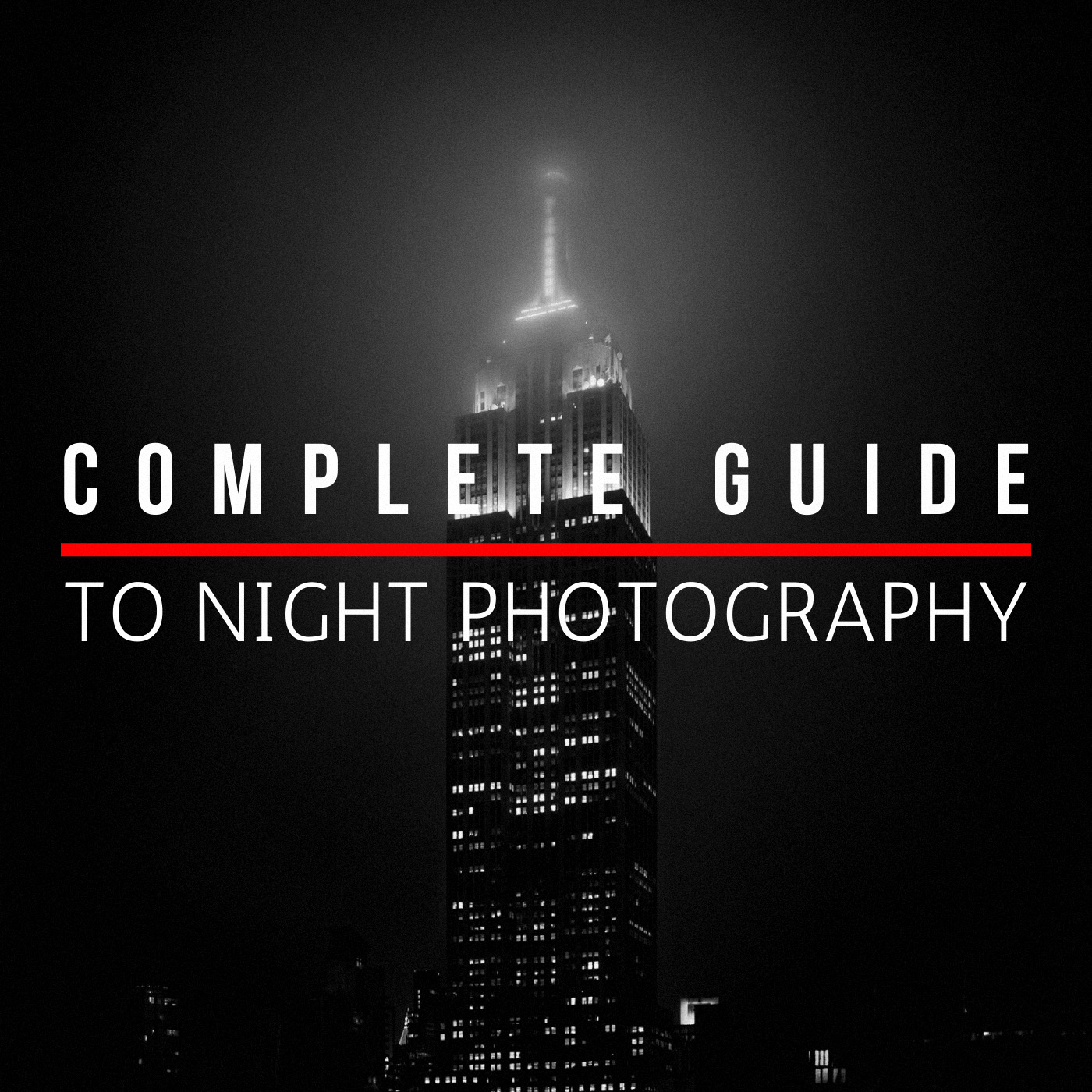

COMPLETE GUIDE TO NIGHT PHOTOGRAPHY
In this complete guide to night photography, I will tell you everything you need to know about how to take photographs at night. From discussing technical aspects of night photography, to how to use your gear when you shoot at night, we will touch everything and will go all the way to what can give you inspiration and help you make outstanding photographs by night. This guide is, to my knowledge, the most complete guide to night photography available freely online at this moment.
I will be adding information and ideas to this guide as I go, so if you want to learn more about night photography and follow the updates, subscribe here to receive any new additions to this guide, as well as any new free tutorials I will be releasing in the future.
Except for this guide, I have created several complete guides to different aspects of photography, which have helped many photographers. If you want to consult them, have a look at my tutorial section .
When the light of day disappears and the stars make their appearance in the sky, a new world comes to life. The world of deep shadows and subtle highlights, the world of night photography.
Night photography is so mysterious, and it stimulates your imagination so much that it can become addictive. This is a time when everything goes quiet, and you can be with yourself, creating images that would not be possible during the day.
Night photography is the land of imagination, and this is one of the most important reasons why, when shooting by night, you can create the most outstanding fine art photography.
Before starting this complete guide to night photography, if you want to have a look at my night photography portfolio and the limited edition print series I am creating for my night photography, as well as for my other photography, here is where you can find all my limited edition prints .
Also, before starting I’d like to invite you to join me in Chicago for my next (en)Visionography Workshop – The Art of Black and White Photography Processing. At this moment there are only 2 spots left. We’ll have a blast, learn a lot and shoot some of the most amazing buildings in the world.
WHAT IS NIGHT PHOTOGRAPHY
Night photography is a genre of photography we create without needing to rely on high levels of light to create our images. In night photography, instead of looking for bright light to reveal all the details and secrets of the subjects we photograph, we look for subtle light sources that bring to life specific details and hide others, revealing a different reality than the one we see by day.
Even if we use the same equipment and basic techniques, night photography is fundamentally different from daylight photography, both from a technical point of view and in terms of the creative process.
At night, everything is slower, from the slower shutter speed we need to record images, to the rhythm of life happening in front of us and that we capture in our images.
Night photography is a more contemplative type of photography, an almost meditative photography where we are more interested in what is not shown and what is implied than in what is well seen. Night photography is full of symbols and riddles, and we can use it in a poetic manner, to tell the story of an unseen world.
Among many other subjects related to fine art black and white photography, you can also read a chapter on night photography in my best-selling book From Basics to Fine Art – Black and White Photography – Architecture and Beyond , a book that helped thousands of photographers improve their black and white photography and their fine art photography in general and that I warmly recommend you to read.

WHY NIGHT PHOTOGRAPHY
Why shoot night photography why, really.
When I started doing night photography more intensely, except for curiosity, it was for two reasons. One reason was that I wanted to extend the time I was photographing beyond what I could do in during the day. Another reason was that at night there are fewer people around, fewer cars in the street, and less clutter so it is easier to photograph even in the heart of the city.
You have to like the night to be able to fully enjoy night photography. You need to like the calmness and the solitude the night provides and be comfortable with the lack of light. But if you like that, I can guarantee you that you will love night photography as it will help you discover a totally different world than the one you see during the day. The lack of light and the lack of people reveals an image of the world that can be completely different than what you see by day. This is when you can notice details you wouldn’t notice by day and have experiences that wouldn’t be possible in daylight.
This is what you look for when you shoot at night – a different experience, a different emotion that only the mystery of the night can give you. That rush of dopamine that you have when you know you are one of the few people around and one of the few seeing the scene in front of view in a different way than how everyone sees it by day. And in addition, that rush of adrenaline, when you feel a bit on edge because you cannot control the situation as well as you would during the day when you can see everything and you are not alone. That sensation of heightened senses can be offputting for some, just as it may be simulating for others, but you will definitely not be indifferent. However, if you prepare well and are careful where you do night photography, it can be a quite safe experience, despite the first impressions.
No matter how you look at it, night photography will give you some of the most inspiring experiences in photography and I highly recommend trying it if you haven’t already. If you want to find out how to get inspiration for your photography, in night photography and in general you can read my recent popular article How to Find Inspiration in Fine Art Photography .
Beyond the particular experience, in terms of pure photography, what night photography can give you is and more selective way of capturing the reality in front of you. Since you will have less clutter and see fewer things, you can focus more intently on what is important in your image. You can use the shadows to hide the things you don’t want to see and use the limited light to bring to attention the things you want to reveal. You can use contrast more effectively and create a more surprising word in your photographs than what you can do by day. This is one of the main aspects of night photography that appeals to me and why I like to photograph at night.
COLOR NIGHT PHOTOGRAPHY vs BLACK AND WHITE NIGHT PHOTOGRAPHY
Most of the night photography that you can see if you look around is done in color. You may think that color is more fit for night photography because you are seduced by the warm color of the light or the different nuances we can find in the light when the light sources have different colors. The truth is that color night photography can be quite seductive, just like color photography in general, because the element of color is very powerful in creating an impact on the viewer.
However, just as in the case of color photography vs. black and white photography in general, the difference between the two is that color photography seduces you with the color, while black and white photography offers you a more intense emotion since in black and white photography we can touch the essence of the story more deeply. In black and white photography we don’t have the color to seduce the viewer and create a “saturation” of the emotion that is based only on the color, so we can focus more attentively on the light and shapes to understand their message.
Night photography is even more about the light than daylight photography is. That is happening because, in night photography, the light is more subtle, it is scarce, and it can be used more efficiently in highlighting specific elements while concealing others. Besides, light in itself does not have any color. The fundamental form of light is white, so it would make more sense when we talk about the essence of light to think about it in intensities of black and white rather than in different nuances of color.
The fact that the intensity of the light is the most important thing in night photography makes black and white photography an even more powerful tool for studying the alternation between brightness and darkness and the way this alternation reveals the details in a photograph.
Maybe that is where the magic of black and white photography lies and why it creates such a profound impression on us. Studying the light in shades of whites and grays, without the addition of the color, opens for us the possibility of closer contact with the light and with what it stands for.
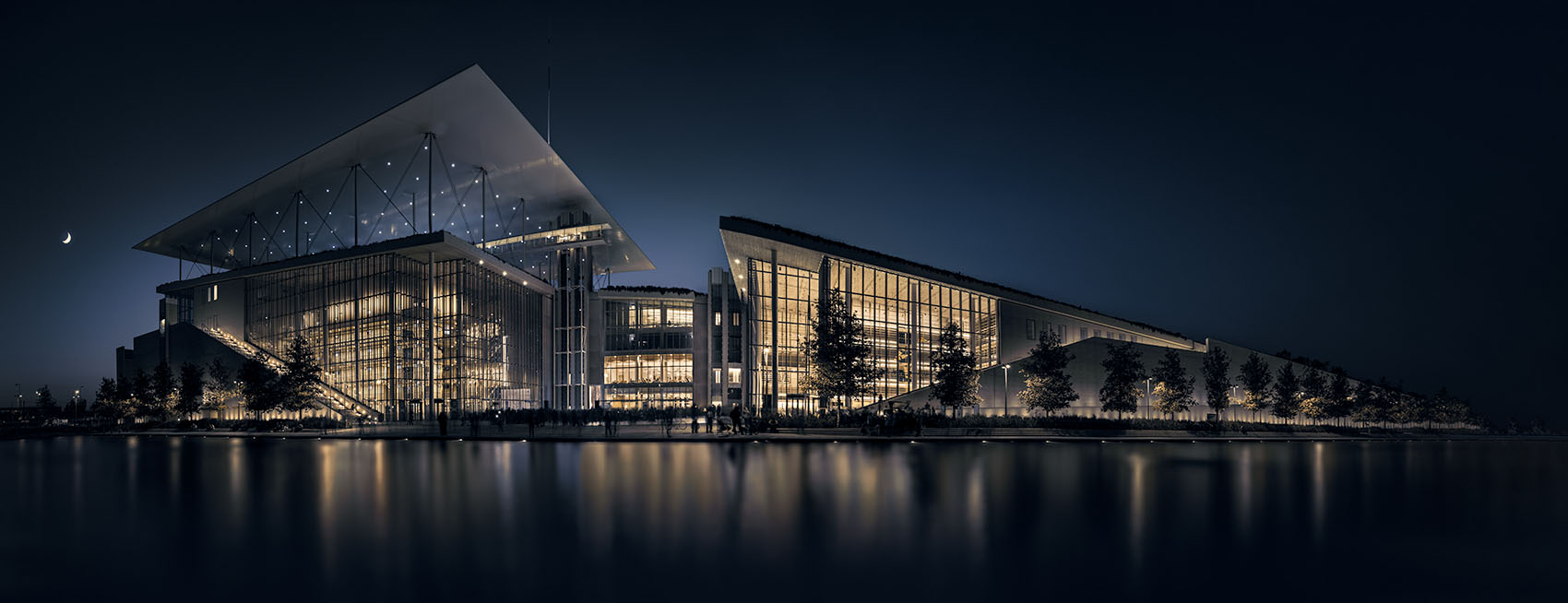
WHITE BALANCE IN COLOR NIGHT PHOTOGRAPHY – WHIT A LITTLE HELP FROM SPECIAL FILTERS
In terms of capturing color night photography vs. black and white night photography, there are not many technical differences, except for the fact that you will need to be more careful with the color cast that light can have when shooting in color because it will be visible in your final image.
In that case, you need to either customize your white balance in the camera or tweak it in post-processing, so you get the right light nuances in your image. In black and white night photography, you will not need to bother with white balance too much. However, it’s always useful to set that correctly and have it in mind because you never know when you may want in the future to work on the images you capture in color and when in black and white.
As a rule, you can start with Auto White Balance which will give you the best all-around white balance, and in case you find that Auto White Balance does not do the trick, you can customize it, either setting it to Fluorescent or Tungsten, which are both artificial light settings, or if the conditions are more challenging you can create a custom white balance. All cameras will have these settings available. You only need to experiment with them to see what works best for each situation. You can start by setting the light temperature between 3500K – 4500K, which tends to do a good job for most situations and move from there.
Another easier way to deal with the color cast when you shoot night photography is to use a special night photography filter that I will discuss further in the article, the Formatt-Hitech Firecrest NightScape for which you can use my discount code JULIA10 to get 10% discount . Keep reading, and you will find out what I’m talking about and why this is such a fantastic solution.
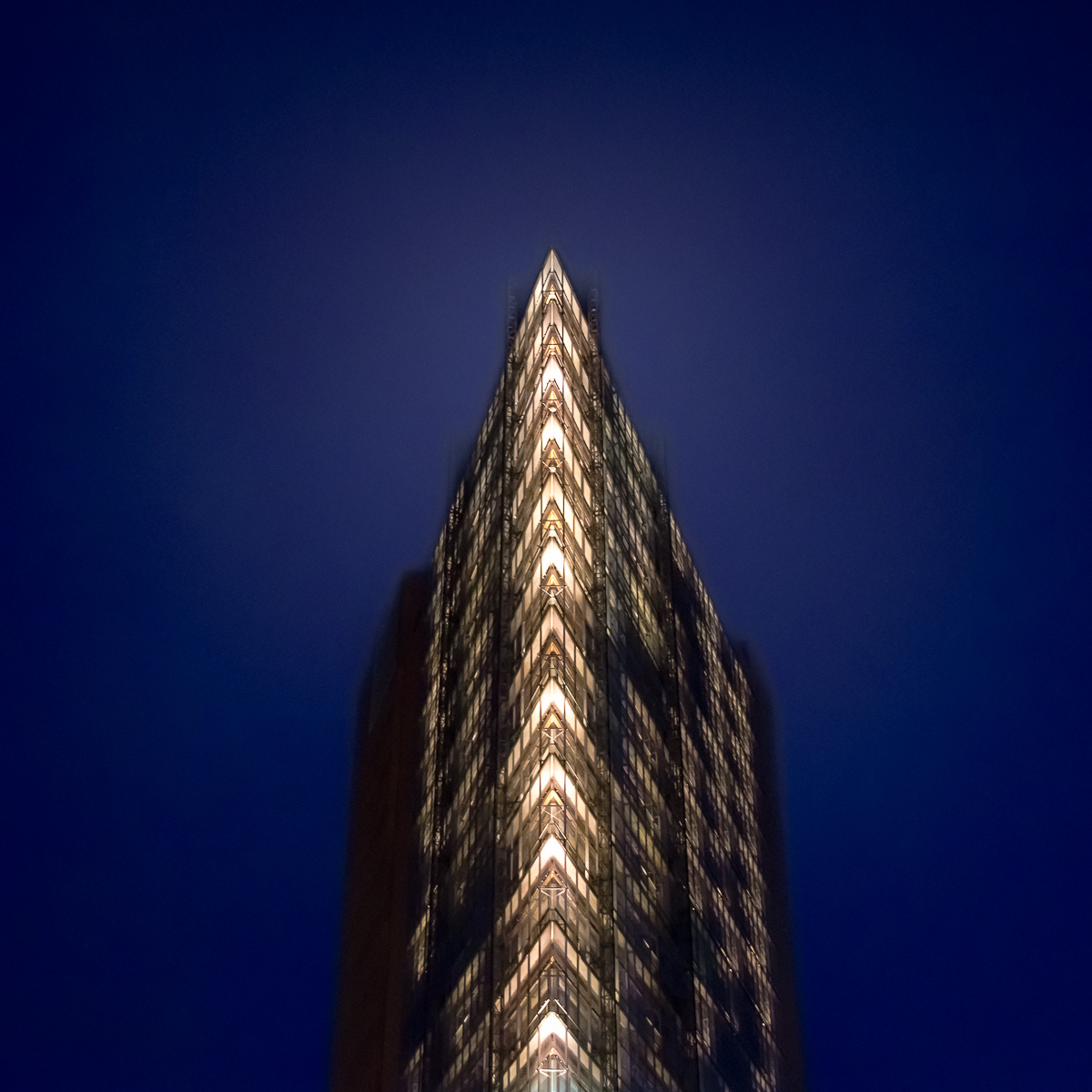
NIGHT PHOTOGRAPHY BEST TIME TO SHOOT
Obviously, the best time to shoot night photography is at night. But in photography, the night starts earlier than the moment when the sky goes black. It starts after sunset.
The best moment to start shooting night photography is after dusk, and you can keep shooting well into the night. Dusk is the time toward the end of the astronomical twilight after sunset, just before the night sets. It is the moment when the lights start to come out when you are shooting in the city or when the moon or the brighter stars already start flickering in the sky when you are shooting the outdoors.
At dusk, the sky is not yet completely black as later in the night. It is still dark blue, and the light has a deep pinkish hue. This dark blue tint in the sky is what I like best about shooting at this time of the day. It creates great color contrast as a complementary color with the warm hues of the light sources and helps guide the viewer into the image.
Especially for black and white photography, capturing this dark blue tone in the sky means that when you convert your image to black and white, instead of having a pitch-black sky, you will have a dark gray sky that has more depth and detail than a completely black sky. That is happening because even if the sky is dark, you will still have captured the last remaining light of the day, so instead of a black sky, you will have a dark gray one when you convert the image to black and white.
Dusk is a magical time for photography. It is the time when the day melts into the night and when you still have some of the soft light of the day, but you also have the darker shadows of the night. When you shoot in the city at dusk, you also have artificial lights that can add atmosphere to your photographs.
While when you shoot landscape night photography, the light throughout the night will be mostly constant, and you can keep shooting, if you shoot night photography in the city, you will want to do that while the city has the best lighting. Part of the lighting in a city is provided by the street lights which are lit throughout the night.
Another interesting aspect of shooting in a city is shooting the different buildings and structures that are artificially lit at night, and in some cases, that lighting is only on until a certain time. It depends from case to case, and in some cases, the lighting can be on all night, but you have to do your research and know beforehand for how long the artificial lighting of the buildings will be on, so you can plan your shooting session during those times. It would be useless to go shoot the Empire State Building in New York or the Louvre Museum in Paris at 3 AM if, for instance, the artificial lighting goes off by 2 AM. I’m saying this because I experienced it myself on several occasions when I thought the lighting would be on for longer into the night, while it wasn’t the case. Normally, the most important locations will be lit all night, but some others may be lit for a limited time each night, and it is a good idea to know the situation in each case.

NIGHT PHOTOGRAPHY CAMERA SETTINGS
Exposure length – long vs short exposures.
In night photography, almost without exception, you will have to use a longer shutter speed than when you shoot by day. Even when you need a fast enough shutter speed to freeze motion, you will choose the lowest possible shutter speed that would freeze that specific motion. That is one of the fundamental differences between daylight photography and night photography.
That being said, there are two approaches to night photography in terms of exposure length.
The first approach is, as we mentioned before, using a fast enough shutter speed to freeze motion. The second approach is to use a longer exposure to record the motion in the image. Let’s analyze both of them.
SHORT EXPOSURES IN NIGHT PHOTOGRAPHY
That is the case when you need to have everything sharp and immobile in your image. That may mean people moving, cars moving or the stars in the sky moving. You want all those elements to be sharp and you want to freeze the movement.
When you need to freeze the movement, depending on how fast the movement is, you will choose the lowest shutter speed that can freeze that movement. That is happening regardless if you shoot handheld or you place your camera on a tripod. For instance, when shooting people walking, a shutter speed of 1/60 is a good start. You may need to increase that in some cases but I find that 1/60 is the lowest I would go when shooting people in the street. On the other hand, if you shoot the night sky and you want to have the stars sharp, you can increase your exposure up to 15 or even 20 seconds before starting to capture movement in the stars, the so-called Star trails. Remember that these are values that you should use with wide-angle lenses. If you use longer lenses, the shutter speed has to be faster.
Faster shutter speed is also needed, regardless of the movement in the scene, also when you shoot handheld so the movement of your hands and body don’t introduce motion in the image.
While a fast shutter speed may freeze action, it will be impossible for you to shoot with a fast shutter speed at ISO 100 and get any kind of usable exposure in your image by night. This is because it will be too dark. So what we do in that case is that we increase the ISO to make up for the lack of light.
All nice and beautiful so far, however, if you have any kind of experience with higher ISO you will know that even if the cameras are becoming better and better, they still have a lot of issues with higher ISO and if you increase the ISO beyond a certain value you will start getting a lot of noise. Actually, high ISO quality is one of the things that has improved the slowest compared to other capabilities of modern cameras. It is getting better, but it still needs quite a bit of work. So you have to try to limit the increase in the ISO in order to not get too much noise in the image. Noise, especially in the form of grain that you can have if you shoot film, can be interesting, but it will take away from the sharpness and detail of your image, and it is not always suitable for any kind of photograph.
As a rule, and of course, this depends on how much light you have in the scene, I am trying to not increase my ISO over ISO 1600 when I shoot street or urban photography or general night photography. Sometimes I may increase it higher, to ISO 3200 or ISO 4000, but it will only be if I have no other choice.
BRACE YOURSELF
When you shoot handheld, you need to use your body to stabilize the camera in order to get sharper images even at a slower shutter speed and not need to increase your ISO so you can increase the shutter speed. A good stability tip for shooting handheld is to make the most out of what the camera offers you but also out of what you can do with your own body to increase the stability of the camera.
The first thing you can do is to activate the vibration control on the lens or camera so the camera itself makes up for the movement of the camera when you use a slower shutter speed. But to increase that possibility, try to find a steady vertical surface to lean against so your body movements are minimal and do not add vibrations to the camera. You can use a wall, or light post in the city, or a tree or rock if you’re shooting the landscape. Brace your arms against your body and slightly spread your legs apart on the ground for better stability. Your body and the camera have to become one, so the camera can be as stable as your body. Also, do not inhale/exhale when pressing the shutter. It helps to keep yourself as immobile as possible.
By using this technique, I was able to shoot exposures of even a couple of seconds while keeping everything sharp and getting enough light in the scene without needing to increase my ISO.
LONG EXPOSURES IN NIGHT PHOTOGRAPHY
Another approach to night photography is, instead of shooting with a fast shutter speed, to use a longer shutter speed that will give you enough time to record the light correctly in the image without needing to increase your ISO. This is my first choice for the cases where I don’t need to freeze motion, and since most of the time I’m not trying to freeze motion in night photography, I will be using this technique 80% of the time and only use fast shutter speed when I shoot street photography at night.
The most important thing you need to be able to get a long exposure, both by day and by night, is to place the camera on the tripod so the camera doesn’t move at all during the exposure. That gives you the freedom to increase the exposure as much as you like until you get the effect you need without increasing the ISO and without getting a blurred image.
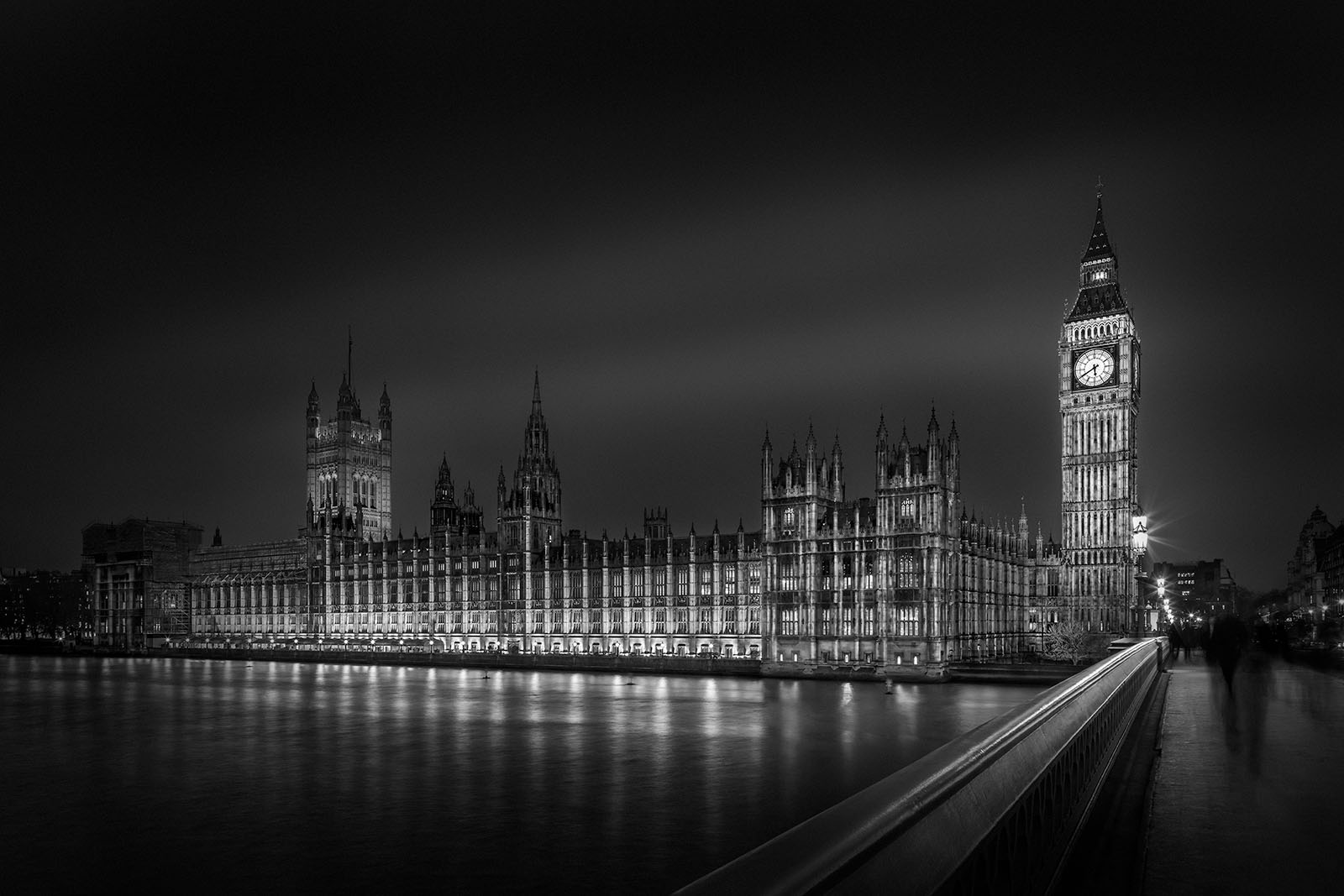
NIGHT-TIME VS DAYTIME LONG EXPOSURE PHOTOGRAPHY AS AN ARTISTIC DECISION
Just like when you shoot by day, when you shoot night photography, you can use longer exposures for practical reasons or as an artistic decision. Your exposure can be long enough so you can capture the right amount of light in the image, or you may consider lengthening your exposure even beyond what would be enough to capture the light you need in the image in order to create an effect specific to long exposure photography: long streaks of clouds, soft surfaces of water, motion blur in the people or the cars passing by.
When you use long exposure as an artistic decision, you will treat night long exposure photography in the same way as you would if you were creating daylight long exposure photography. In both cases, if you aim to create photography as an artistic decision, it means you aim to create fine art photography so you will be more interested in expressing an emotion through your photography than merely recording the scene in front of you. To learn more about how to create fine art photography you can have a look at the tutorial section I have on my website where you will find a lot of information on this subject. To start, you can read this article About Creating Art and Fine Art Photography .
When you shoot long exposure photography at night, with the intention to create the specific effects of long exposure photography that we want to create also by day, soft clouds and water etc., you will need to use neutral density filters to lengthen the exposure beyond what is necessary. However, when you shoot long exposure by night you will need less strong neutral density filters to create the same effect intensity as you would by day.
For instance, if you want to create a certain amount of softness in the clouds or water that you would create by using a 16-stop neutral density filter by day, you may need only a 6-stop neutral density filter by night. The rest of the lengthening of the exposure will be done by the night itself that anyway requires longer exposures.
Depending on the effect I want to create, I generally use either a 6-stop neutral density filter or a 10-stop neutral density filter when I shoot long exposure by night.
You can work with any neutral density filters, but the ones I recommend are the Formatt-Hitech Ultra IRND neutral density filters which are the best in terms of quality and in dealing with color cast. For any Formatt-Hitech filter or any other accessories you may need, you can use my discount code JULIA10 to get 10% discount if you order from Formatt-Hitech US or from Formatt-Hitech UK .

ANY Formatt-Hitech product – filters, holders etc. discount 10% OFF – CODE “JULIA10”
These are the neutral density ND filters and accessories I am working with to create my long exposure photography and you can see the great results in my many award-winning images. Formatt-Hitech was the first to create truly neutral ND filters back in 2014 , the Firecrest line, the first to create an “anti light-leak” holder, and they keep innovating with the new Firecrest ULTRA ND filters.. This is why I work with this brand. It gives me the best results. Get 10% OFF discount for any Format-Hitech product – ND filters, ND grads, polarizing filters, holders, accessories from the link above with code “JULIA10”
CALCULATING THE RIGHT EXPOSURE FOR NIGHT PHOTOGRAPHY
The “bump up iso rule”.
A good tip to use when you want to check the exposure you need at night is to use the “Bump Up ISO Rule”. Don’t try to find a rule with this name out there, I just made up that name. I think that this name can help you remember this rule easily so you can apply it when you need it.
This rule is based on the exposure triangle, which says that ISO, shutter speed, and aperture are interdependent, and when you change one of them by a number of stops, in order to get the same results, you will need to make the same change to another in the opposite direction, to make up for the change in the first. For instance, when you increase your ISO by 1 stop and want to get the same exposure in the image, you would have to decrease your shutter speed by 1 stop or close your aperture also by 1 stop to get the same exposure as you had before increasing your ISO.
When using the “Bump Up ISO Rule” you can find out the needed exposure without actually having to take the photograph which means sometimes waiting even for a few minutes for the exposure to end if you shoot a long exposure.
What you have to do is to take a test shot by bumping up your ISO so you can use a shorter exposure and then calculating what exposure you will need if you go back to a low ISO. It is something like reverse engineering because you need to do a bit of calculating to find out the exposure, but it makes things easier and definitely quicker than actually taking a shot to see if it works or not.
For instance, if you know that you want a certain aperture, let’s say f/8, you can set that aperture on your camera with the shutter speed of let’s say one second and then bump up your ISO until you get the right exposure on the back of your camera or by looking at the histogram or the exposure indicator you have on some cameras. When you reach the right exposure according to the image you see, make a mental note of your ISO and calculate how many stops you increased your ISO starting from ISO 100. For instance, if your resulting bumped-up ISO is ISO 3200, that is a difference of 5 stops between ISO 100 and ISO 3200. So if you got back to ISO 100 you would need to increase your exposure by 5 stops in order to make up for the lower ISO.
This means that, in order to get the right exposure for aperture f/8, you will need to increase your exposure from one second to 32 seconds to get the right exposure. From one second to 32 seconds you have an increase of five stops, the same increase you had in your initial bumped-up ISO.
HOW TO USE APERTURE IN NIGHT PHOTOGRAPHY
Aperture in itself will not make a difference in terms of sharpness for night photography. Where aperture can become important is in controlling the depth of field. Of course, you can use aperture to control exposure in the sense of using the shallower depth of field to let more light reach the sensor so you can keep your shutter speed faster and your ISO lower.
The decision to use a certain aperture starts from deciding how much depth of field you want in your image. This should be the first reason for you to increase or decrease your aperture. This has to do with the style of photography you are shooting, and if you shoot street photography, for instance, you may want a shallower depth of field so you can focus better on your subject against the background, while if you shoot architecture or landscape photography, you may want to go with a deeper depth of field.
In my photography, I try to keep the depth of field as the most important factor in determining my aperture, regardless if I shoot at night or by day. If I want a larger depth of field, to keep the amount of light I need for a certain exposure steady, I will use a higher aperture of f/8 or f/14 (I am trying to not close my aperture too much because I risk getting diffraction which is what happens when your aperture is beyond f/16), and will decrease my shutter speed, so I can get that depth of field without increasing the ISO. That especially applies to my architecture and landscape photography. In street and urban photography, I may decide to increase the ISO if I need a faster shutter speed.
One thing I generally don’t do is decrease my aperture more than what is safe in terms of depth of field just to make up for the limitation of the shutter speed. That has, of course, to do with your style of photography, but for me having crisp detail and as little noise as possible is very important. So I am trying to not sacrifice depth of field or image cleanness by decreasing the aperture or increasing the ISO. I will rather decrease my shutter speed if I cannot get the exposure I need in any other way, and to make up for the slower shutter speed, I will use a tripod.
However, there are cases where if you shoot an object that is far away, you can safely decrease your aperture up to a quite low value while not sacrificing your sharpness and depth of field. What is important in that case is to not have a subject in the foreground very close to the camera and that you need to be sharp. In those cases, I may go to f/5.6 and even shallower without sacrificing sharpness or depth of field, while being able to keep my shutter speed fast and the ISO low.
The depth of field has also to do with what kind of camera you use to shoot. I’m shooting with a medium format camera that has a shallower depth of field by nature, so if you shoot with a full-frame camera, a crop frame camera, or a micro four-thirds, you can decrease the aperture even more without losing the depth of field.
In astrophotography, it is very common to shoot at f/2 or f/2.8 aperture so you get the lowest ISO while capturing as much light as possible. Astrophotography is a special situation with particular requirements so I would recommend using such a shallow aperture only if your subject is really far away and if you truly need to keep your shutter speed fast enough to avoid motion in the stars. We will talk about that later in the article, but it is a good point to make already since we’re talking about aperture now.
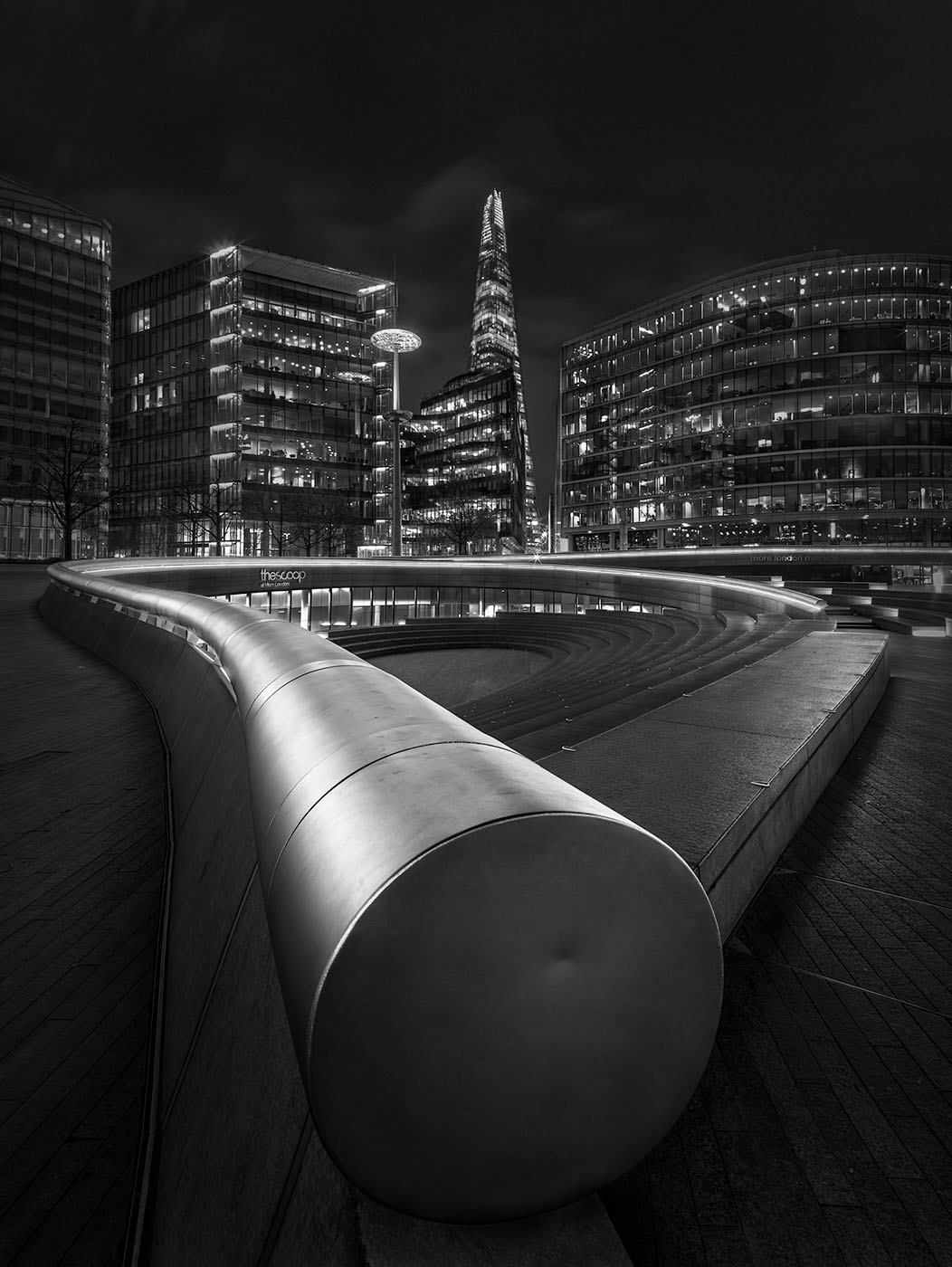
HOW TO USE ISO IN NIGHT PHOTOGRAPHY
Coming back to the ISO. Yes, it is an important setting for night photography and we have to study it thoroughly in this complete guide to night photography.
For night photography, especially if you want to be able to shoot without a tripod, you need to make sure that your camera is behaving well at a higher ISO.
Even if you make a promise to yourself that you will always use a tripod when you shoot at night, I can assure you that there will be moments when you will be inspired to shoot handheld, and those are the moments where you need to know that your ISO can handle that.
Cameras have become better and better at higher ISO, and happily, this is changing very quickly. I remember how weak the first digital cameras were in shooting higher ISO. Even as recently as a few years ago, you couldn’t expect to get very good quality when shooting above ISO 400 on a digital camera. That tends to improve quickly lately, which is a huge advantage for night photography. However, there is still a long way to go. You will still get the best quality in the details and the most amount of information when you shoot with the native ISO of your camera, most of the times ISO 100, or ISO 200 with some Nikon or PhaseOne cameras. But as we go, using higher ISO becomes easier and easier, and I expect this will not stop here but will continue in the future. And that is great news!
For now, I would still recommend shooting as close as possible to your camera’s native ISO, which, as we said, is in most cases ISO 100, so you can get the best detail and the least amount of noise.
The problem with higher ISO is, of course, noise. Noise is the equivalent in digital photography of the grain we know from analog photography. If you ask me, grain looks more elegant and stylish than noise, but both of them have the same effect on the details, which is that they make details less sharp and the general aspect of the photograph less smooth and clean. So we want to avoid that, which is why we need to shoot the closest we can to ISO 100.
At night, however, ISO 100 requires longer exposures, and sometimes we don’t want that, so we may need to use higher ISO from time to time. If you can keep your ISO below ISO 400, that can give you an almost perfect result with most cameras. ISO 800 is still good, and some cameras will give you decent results when shooting with ISO 1600 or ISO 2000. But try to not go over that unless it is absolutely necessary because then you may start having some issues with the cleanness of the details.
The good thing about a higher ISO is that lately we have quite a few great tools to deal with higher ISO in post-processing, which can expand the range of ISO we use quite a bit. There are a few denoise plug-ins out there that work quite well and that I warmly recommend you to use, not only when you shoot at higher ISO, but especially when you do that and especially for night and long exposure photography.
My favorite denoise plug-in is Topaz DeNoise AI . This is the plug-in I use on all my images, even those that don’t have a lot of noise, because it gives me great textures in the sky. But I will always use it when I shoot night photography and long exposure photography, and every time I shoot with a higher ISO. If you want to get Topaz DeNoise AI you can use my discount code JULIAG to get 15% discount when you order from the link above.
Another great denoiser is ON1 NoNoise AI which is a good alternative to the Topaz DeNoise AI, and DxO PhotoLab has a great denoiser also, if you happen to use the software. I have a discount code for On1 NoNoise AI too. You can use my discount code JULIAG20 to get 20% discount when you order from the link above.
I can tell you that a good denoiser is the night photographer’s best friend, along with being the long exposure photographer’s best friend, because both night photography and long exposure photography can give you issues with noise. So investing in a good denoiser is one of the best pieces of advice I can give. A good denoiser and a good sharpener, like, for instance, the Topaz Sharpen AI are the best tools I can recommend when working with your RAW file if you want to get the best out of it. And you c an get discounts from Topaz Sharpen AI from the link above, just like from Topaz DeNoise AI, just like you can use it for any other Topaz plug-in.
FOCUSING YOUR CAMERA FOR NIGHT PHOTOGRAPHY – HOW TO SEE IN THE DARK?
Focusing at night can be challenging. Especially when there is not enough light for the camera to find strong enough contrast for the autofocus to work well. This can happen when you shoot in nature, relying only on the natural light and when you shoot astrophotography, and your subject is the night sky. In those cases, you have a few options.
One of the options is to switch to manual focus. Manual focus will give you more control over the focus than if you use the autofocus which may be hunting if there’s not enough light or enough contrast.
If the subject you photograph is far in the distance, you can set your focus to infinity. That will work well especially when you shoot with a wide-angle lens since in that case you have a higher chance of having everything in focus from foreground to background than when you shoot with a longer lens. For some lenses, you will want to back off a little bit from infinity to get the best sharpness. The best is to experiment with all your lenses in daylight and see what stands for each of them before going out to shoot at night.
Another way of focusing in a scene that doesn’t have enough light for the autofocus to work, is to use a flashlight to brighten the area where you want sharp so you can use the autofocus, however, this is something that works when your subject is close enough so the flashlight reaches it.
A trick I’m using when I shoot landscape photography at night is to use one of those laser pointers used as presentation indicators whose beam is strong enough to reach quite far. This way I can point the indicator to the area that I want sharp and use the autofocus to focus on the pointer’s light.
Another good tip is to use the focus peaking feature of your camera in combination with manual focus to see which area is in focus and set it manually. If you have a more modern camera, it is highly probable that your camera has this feature.
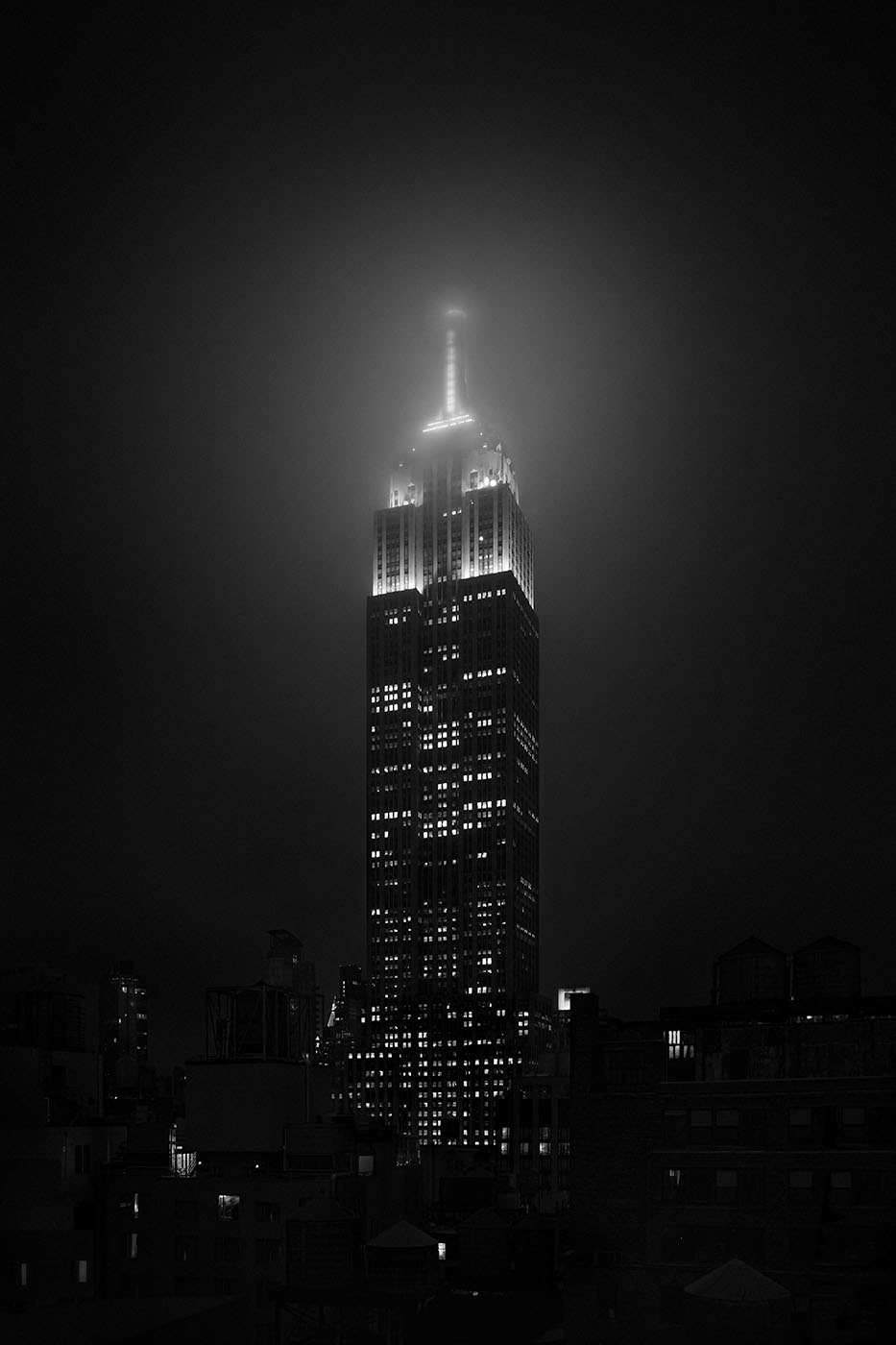
OF COURSE, YOU SHOULD ALWAYS SHOOT RAW
I don’t think I even need to mention that, but just to be sure, I will say it just in case some of you may be wondering, or in case some of you are not as familiar with the power of RAW files.
Not only for night photography, but especially when you shoot at night which is always more challenging, you should ALWAYS shoot RAW.
Actually, you should always shoot RAW, no matter when you shoot or what subject because that is the only image format that can give you the best quality your camera or any camera can produce. Only when you shoot RAW can you get the most of the settings you make on your camera. And what’s more, when you shoot RAW, you have much more space to push the limits of your camera and the limits of your post-processing. Only a RAW image allows you to extensively edit your image while still maintaining top quality.
Shooting RAW is much more forgiving in terms of how far you can underexpose or overexpose, how far you can push your ISO, and it gives you much more leeway in how much you can retrieve out of an image taken in challenging conditions.
So, don’t even think about it, just shoot RAW all the time, and if you also need a JPEG ready while you’re shooting, just set your camera to shoot both raw and JPEG.
NIGHT PHOTOGRAPHY EQUIPMENT
Why the tripod is a must for night photography.
One of the tools I want to talk about in this complete guide to night photography is the tripod. We have already mentioned the need to use a tripod for night photography, and I am insisting on this because it is the single most important thing in night photography and what truly differentiates it from photographing by day.
At night, the only way you are 100% sure that you will get sharp images is by placing your camera on a tripod. Every other technique you may use to get sharper images will have some limitations and will be more difficult to apply.
When you set your camera on a tripod, you know that, no matter what you do, the camera will be stable, and it will record the scene in front of it with zero motion. Of course, we are talking here about a stable tripod that does not vibrate, so it is important where you place your tripod when you shoot. But that is important during the day as well, and if you want to learn more about how to use a tripod during the day to create long exposure photography, I warmly recommend you to read my extensive article about long exposure photography Ultimate Long Exposure Photography Tutorial . This tutorial discusses in-depth everything related to long exposure photography, tripods, filters, and camera equipment. It also has a section about night photography that will be interesting to study in addition to this article.
Having a good sturdy tripod when you shoot at night is fundamental. In terms of tripods, like with many things in life, you get what you pay for so my advice would be to make a smart investment in a good tripod if you want to work seriously with night photography or long exposure photography. It will always pay off in the end.
There are mainly 2 kinds of tripods, the aluminum ones, and the carbon fiber ones.
The aluminum tripods, the classic tripods, are generally sturdy and resistant, they are also less expensive, but they tend to be heavy so I would only recommend an aluminum tripod if you can move from spot to spot on longer distances in your vehicle and you don’t need to walk around too long caring your tripod. Also, I would not recommend this tripod if you need to travel often by airplane since it will increase the weight you will carry, and as you know there is always a limit to the weight you can carry when you fly and I can tell you from personal experience that I am always at the limit when traveling for photography assignments or workshops.
The carbon fiber tripods are more expensive but they are quite light so they are more easily carried from place to place and they don’t break your back when you hike or walk for a long time. Also as I said previously, it is going to be easier to pack them when traveling by plane because they will weigh less.
What I use most in terms of tripods are the Gitzo tripods and I have a larger and more sturdy one, the Gitzo Systematic GT4543LSUS as well as a lighter travel style one, the Gitzo GT2545T Traveler Series 2 Carbon Fiber Tripod and a Gitzo Series 1Traveller GH 1382QD Center Ball Head . I prefer the sturdy one but especially when I shoot in the city and the conditions weather are mild (not too much wind) it is easier to work with the lighter travel version.
For any Gitzo or Manfrotto tripod or other accessories, you can use my code JULIA10 to get a 10% discount from the link above.
For architectural work, I am also using the carbon fiber FLM CP30-XL PRO tripod with an FLM CB-58FTR PRO ball head that has a very cool feature of locking the ballhead in one direction which helps in fine-tuning the position, a feature useful for architecture photography.
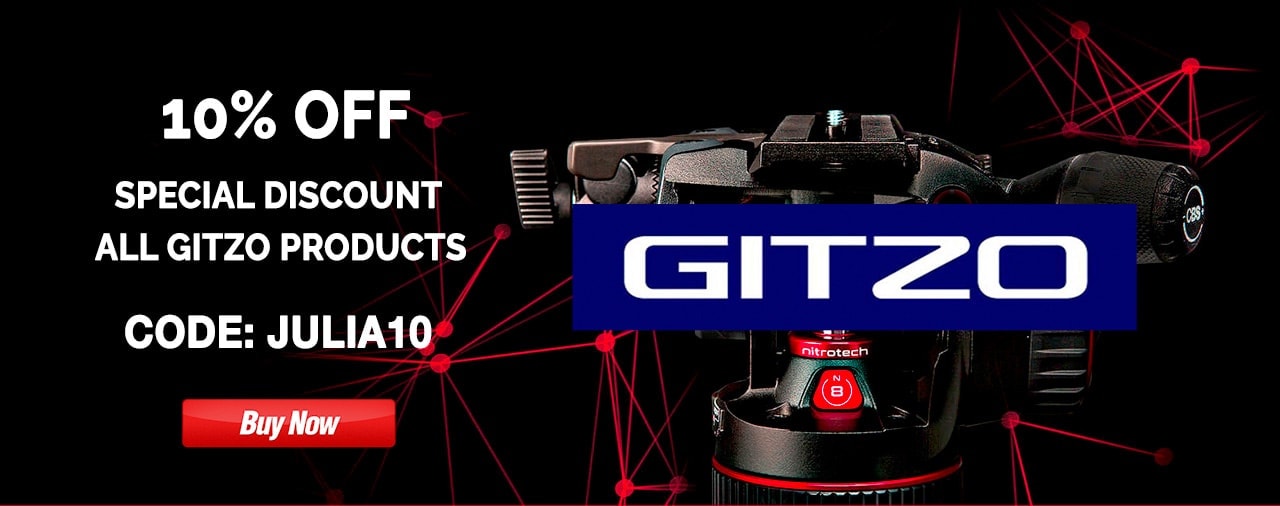
GITZO TRIPOD & ACCESSORIES DISCOUNTS- Some of the best tripods and tripod accessories on the market
REMOTE RELEASE, SELF-TIMER AND MIRROR LOCKUP
An issue you may encounter when shooting at night, especially when you shoot with a slow shutter speed and you have an exposure of a few seconds, is that, when you press the shutter to take the image, you will introduce vibrations in the capture, and you may not get a sharp image. This will be less of an issue the longer the exposure is, but for exposures of a few seconds, the issue can be considerable. To avoid this, you will need to use a remote release, so you don’t need to touch the camera to actuate it.
This is something you need to experiment with and see how far you can go without using a remote release, meaning how stable your hands can be on the camera when you take a photo. This experiment will tell you which are the exposures where you need help from the remote control, and when you can simply click the shutter yourself to actuate the exposure. From my experience, for exposures up to 10 seconds it is a good idea to use a remote control, but as the exposure lengthens, the camera has a much longer time to stabilize, and the motion will not be visible in the resulted image.
A workaround to using a release control may be using your camera in self-timer mode. In that case, you can actuate the camera with your hand without being afraid of vibrations. When you activate the self-timer, the camera will actually start exposure 2 to 10 seconds after you press the shutter, depending on how many seconds you set the self-timer, when the vibrations introduced by your hand on the shutter will have settled.
Another issue you may encounter is with the camera mirror. You don’t need to do this when you shoot with a mirrorless camera because there is no mirror inside the camera. However, if you shoot with a DSLR that relies on the mirror to create the image on the sensor, the movement of this mirror every time the camera takes a photograph may introduce vibrations and may result in a blurred image when you shoot with a slow shutter speed at night. This is why when you shoot with the camera on a tripod at night, it is a good idea to lock the mirror up so it doesn’t move when taking a photograph. This way, you will have the sharpest images possible, even with lower shutter speeds.

BEST CAMERA FOR NIGHT PHOTOGRAPHY
In terms of cameras, most midrange and professional cameras, both DSLR and mirrorless, will be good for night photography. You don’t need specific features in your camera to shoot at night, except for the ability to control your shutter speed, aperture, and ISO.
For longer exposures, it is preferable if you have a camera with manual mode and Bulb function or if your camera can shoot exposures of more than 30 seconds.
An important aspect in terms of quality in the camera that you will want to keep a look on so you get the best results at night, is for the camera to have a wide dynamic range so it can capture enough detail in the shadows as well as in the highlights. You will get a good dynamic range in a recent full-frame camera but where you can expect to have the widest dynamic range and the best quality both in the shadows and highlights is if you work with a medium format camera.
Medium format cameras have become more affordable lately, but they are still more expensive than other cameras, so they are not accessible to everyone. If however, you have the budget to invest in a medium format camera, I warmly recommend it. I have been shooting medium format for the past several years and I have seen in practice time and again how valuable a wide dynamic range is, together with the high resolution and the amazing detail these cameras give you. If you’re interested to know more about medium format cameras, have a look at my complete review of the medium format camera Fujifilm GFX 50S , one of the most reliable medium format cameras, and my extensive article about shooting long exposure with the Fujifilm GFX 50S .
Except for a camera with a wide dynamic range, another useful characteristic of a camera is to have good behavior at higher ISO. When you shoot at night, you either need to lengthen your shutter speed or you will need to increase your ISO. This is why the better quality a camera delivers at higher ISO, the more likely is that you can push the limits of your night photography even further and get great quality images with less noise and better detail. Again, medium format cameras have the edge over other systems in terms of higher ISO quality.
BEST LENSES FOR NIGHT PHOTOGRAPHY
While you can shoot night photography with any kind of lens, there are two types of lenses that will help you most in case you want to freeze motion and limit the increase in ISO that you would need to freeze motion.
The two types of lenses I am talking about are wide-angle lenses and fast lenses.
Wide-angle lenses are more forgiving to camera vibrations and lower ISO. The wider the lens, the slower the shutter speed you can use with it. In addition to wide-angle lenses, if you want to shoot night photography, look for fast lenses, that you can use at a wide aperture. The best lenses are those that go up to f/2.8 or even shallower. The idea is that you can use a fast lens wide open and get more light into the camera. This way you delay increasing your ISO because you have a larger aperture range to work with.
The best combination would be a wide-angle lens that is also fast. With wide-angle lenses, you will get a larger depth of field even when they are wide open so it is easier to use a wide-angle lens stopped down and still get a decent depth of field. This is one of the reasons fast wide-angle lenses are widely used in astrophotography where you need to use as fast a shutter speed as possible to freeze the stars while limiting the ISO so you get better quality images.
If you work with a full-frame camera a wide-angle lens starting around 14 mm or 16mm would be ideal. You can use prime or zoom wide-angle lenses but, with some exceptions, zoom lenses tend to not be as fast as prime lenses. Some good fast wide-angle lenses for DSLR are the Canon EF 16-35mm f/2.8L III USM or the Nikon 14-24mm f/2.8G ED-IF AF-S. If you work with a Sony mirrorless you can use the Sony FE 14mm f/1.8 GM .

ADVANCED APPROACH – SPECIAL FILTERS FOR NIGHT PHOTOGRAPHY
An issue you will encounter when you shoot night photography in the city where you have artificial light is the color cast the artificial light of the street lighting will create in your images. This is an intense yellow color cast that can be very unpleasant and unnatural.
The way to deal with this issue is to use a special neutralizing filter that will remove this color cast. The theater I used to deal with this is the Formatt-Hitech Nightscape filter.
Formatt-Hitech Nightscape is a night filter designed to remove the light spectrums associated with light pollution and sodium lamps.
There are some other brands making this kind of filters, but from my experience, the Formatt-Hitech Firecrest NightScape filter is the best. As I mentioned earlier, you can use my discount code JULIA10 to get 10% discount for this filter from the link above, or for any other Firmatt-Hitech filters, holders, or accessories. You can place the NightScape filter on the lens when you shoot night photography and you don’t need to take it off until you finish. It will not change your exposure as it is not darker than regular glass but will help you get a natural color of the light in all your photographs and I warmly recommend it.
You can see below a comparison between the same image shot by night without any filter and with Auto White Balance and the same scene shot right after using a Formatt-Hitech Firecrest NightScape filter to remove light pollution, and again with Auto White Balance. Both images are the RAW file the way it came out of camera without any color treatment.
You can see the huge difference between the heavily contaminated light color in the first image, shot without the filter and the second image shot with the NightScape filter where the light looks much more natural and the color in general is much more natural because the source of the color cast due to light pollution was removed by the filter. You understand now why I can vouch for this filter at any moment for night photography.
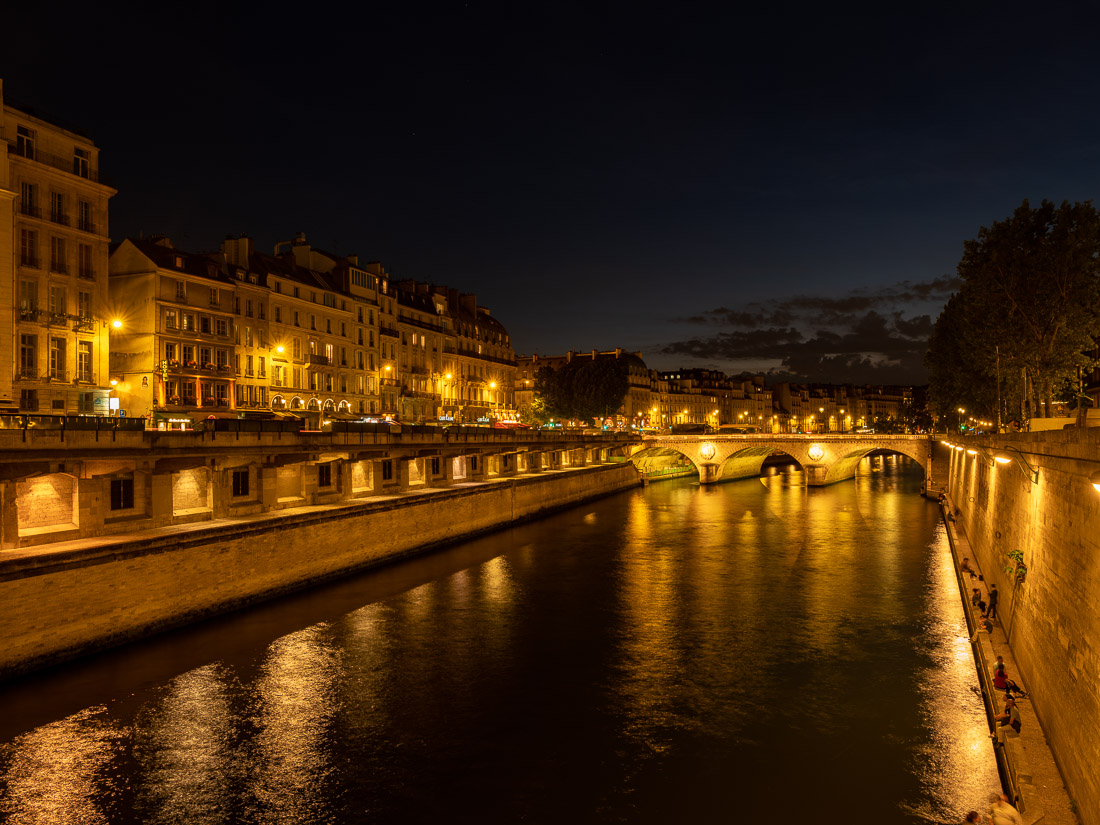
FLASHLIGHT AND HEADLAMP
Except for the camera-specific equipment that you need to shoot that photography, a very useful accessory is a flashlight or a headlamp. You may, of course, use your mobile phone for simple tasks in the dark but if you want to seriously do night photography you will be out there in the dark for an extended amount of time and your mobile phone’s battery will likely not last that long. Besides, by using the flashlight or even better headlamp you can vary the intensity of the light you need so it is brighter or dimmer depending on the task you have to accomplish. One more advantage when you use a headlamp is that you have your hands free and that is a big advantage.
More recently, there are some interesting small LED lights that you can use instead of a flashlight. They work with a battery or are even rechargeable working with solar energy. These lights will give you even stronger light than a flashlight and you can also use them as a source of lighting, for instance, if you want to shoot a portrait at night.
SCOUTING FOR NIGHT PHOTOGRAPHY BEFORE SHOOTING
The most important characteristic of night photography is that you shoot in the dark. This means that in most cases you will not have enough light to be able to use the same workflow as during the day. It will be more difficult to understand compositions and find good angles to shoot, especially when you shoot outdoors where the light sources are very limited. When you shoot at night in the city, you may have more sources of light and it may be easier to understand the scene and find your way around, but outside in nature, this will be almost impossible, especially on nights without moon.
This is why, one of the most important things to do if you want to shoot night photography and get the best results, is to scout your location and find your compositions during the day so when you come back at night you know that you don’t need to search aimlessly in the dark but you know what you have to do. You can check for possible obstacles or random objects that could block your view and see how we can deal with them to get the composition you need.
In some cases, you may set up your camera during the day and wait until it gets dark to shoot your composition.
It is always a good idea when you scout during the day to take some test shots that will help you remember the angles and the exact spots you want to set up your camera. When you come back and night, you can compare those test shots with what you see in front of you and be able to replicate the angle.
Here you need to remember the “Bump up ISO Rule” that we talked about earlier. Increase your ISO as much as you need to see well the scene in front of you and compose, then calculate starting from how much you increased your ISO what your exposure should be if you shoot with ISO 100. This rule works well when you shoot longer exposures. If you want to freeze the stars and need short exposures, then you will rely on the ISO to get enough light on the sensor.
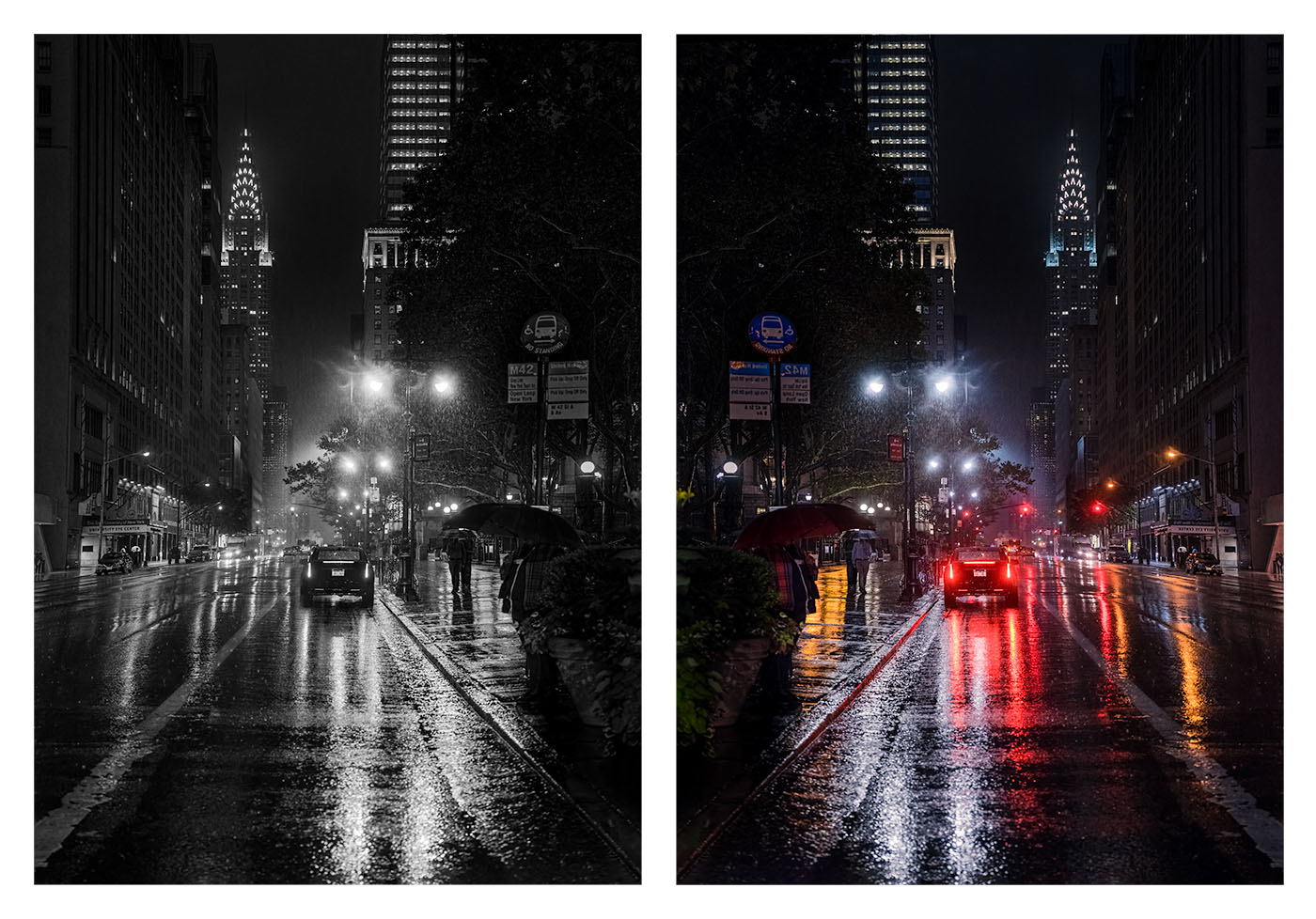
BEST SUBJECTS FOR NIGHT PHOTOGRAPHY
This wouldn’t be a complete guide to night photography if we didn’t talk about the best subjects for night photography.
Night photography has two main sub-styles, which are city or architecture night photography and landscape night photography. Each of them has its own interest, charm, and challenges, and there are specific subjects that work best for each case when we shoot at night.
Let’s see what these subjects are and what are their characteristics in each case.

OBJECT NIGHT PHOTOGRAPHY – BUILDINGS, BRIDGES, TREES, ROCKS ETC.
Object night photography is similar in approach to daylight night photography as to composition and elements that create the image. We are focusing on one object at a time and on highlighting the elements that work best at night, which can be different than those that work best for daylight photography.
These subjects can be either landscape or architectural subjects: trees, rocks, natural formations for landscape photography, or specific buildings, structures, or urban art for city and architecture photography.
PANORAMIC PHOTOGRAPHY – CITYSCAPES, GRAND VISTAS ETC.
Some of the subjects in this category are skylines, cityscapes, big vistas, and distant landscapes.
These are images that can either be approached in a similar way to the daylight ones if we want to emphasize the built environment in the city or the elements of the landscape, or we can look for a different approach if we want to focus on the lighting of the scene. When I’m thinking about the lighting of the scene, I mean the lighting of the city or the buildings in city or architecture night photography, or the light of the moon or the stars in the sky that is something we can do in both landscape or city photography.

STREET NIGHT PHOTOGRAPHY – PEOPLE, CITY LIGHTS ETC.
A particular type of night photography is the photography we can call Street night photography, where we focus on incorporating the human presence into the image together with the backdrop of the city.
While we can incorporate the human presence in landscape night photography, we will have many more subjects for this kind of photography in an urban area where we find more people, even if not as many as during the day.
Some subjects we can work with for night street photography are the silhouettes of people against different interesting backgrounds, an approach that can allow us to experiment with composition and with contrast in light and shadow.
Another interesting subject is motion blur night photography, where we can incorporate the blurred silhouettes of people or cars interacting with the urban environment.
Also, we can focus on the street lights and how they interact either with the people passing by or with the city’s environment – trees, benches, and other urban structures.
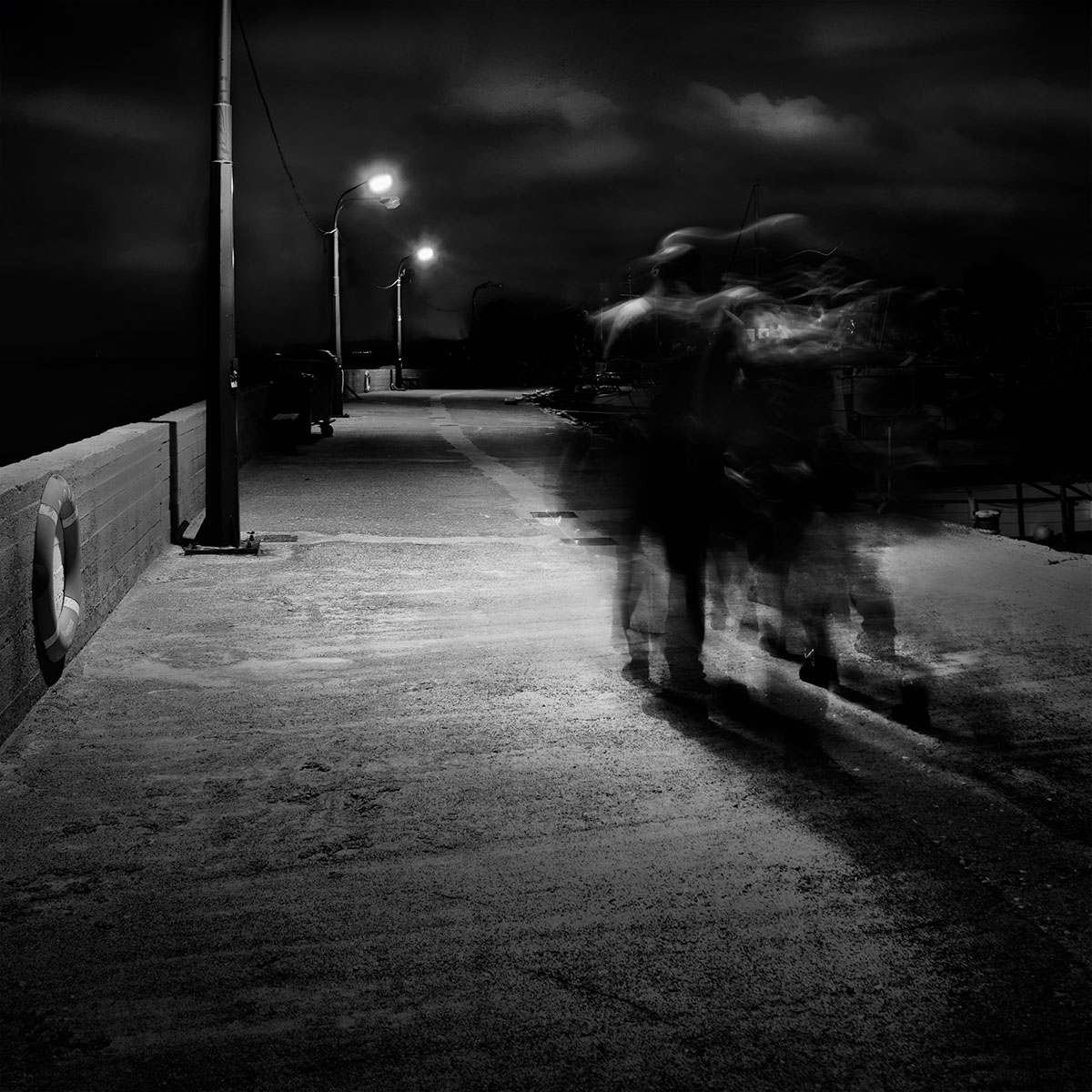
LIGHT REFLECTIONS
Shooting light reflection can be fascinating. You can combine this technique with shooting Street night photography or you can use it to create abstract images of light and shadow when shooting the city lights reflected in water poles, rivers, windows, glass buildings, or other reflective surfaces.
A particular kind of light reflection photography that I like is shooting reflections of the buildings, people, or any urban elements reflected on the wet pavement when it rains. Shooting in the rain during the night can be one of the most fascinating experiences that can allow you to not only play with the mysterious city lights in the night but also with their reflections on the pavement or on any outer surfaces turned into a mirror by the raindrops. I love rain photography during the day too, but at night everything becomes truly magical.
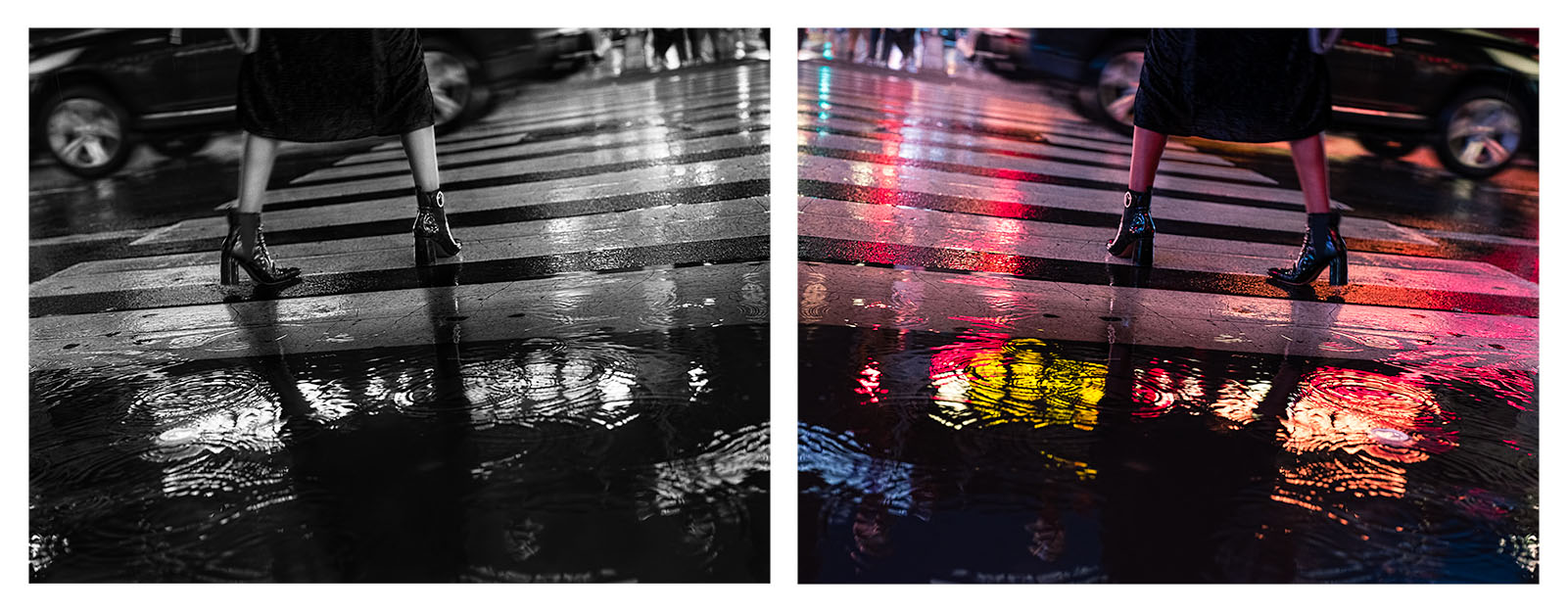
LIGHTING PHOTOGRAPHY – BUILDING LIGHTING, FOUNTAIN LIGHTING ETC.
When we create this kind of photograph, we are more interested in the light as a subject than in the subject of the image itself, and this is a type of night photography that will be more versatile in the city. For instance, we can shoot a building or a bridge lit by artificial light but not for the building or bridge itself but for the way the light is lighting them. We can focus on the patterns the light creates or the way the disposition of the artificial light sources renders a well-known object in a new “light”.
An interesting subject may be the decorative water fountains we can find in city squares that are often lit, sometimes in a very spectacular way. By combining the lighting of these fountains with the smoothness of the water that we can capture when we shoot long exposure, we can create surprising and very original images.
Another approach, in this case, may be seeing the scene in front of us in an abstract way and playing with the artificial lights we have in front of us. Because we have more variety in the city, we can find more subjects for night photography focused on lighting in an inhabited area than in the great outdoors.
NEON LIGHT SIGNS
A subcategory of lighting photography that can also be considered part of street night photography, is shooting the neon lights in the city.
In most cities, especially in big cities, you will find a multitude of situations where you can shoot neon lights. You can find them in brand names or advertising panels hands on buildings or in the street, show names on theaters, like for instance on Broadway in New York, in Theaterland in London West End, or other similar theater district areas, or even in the case of modern street art.
Shooting neon lights can be a good fit for abstract night photography. It can also combine well with shooting reflections when you photograph neon lights reflected in neighboring windows or other glass surfaces, or reflected in water surfaces like rivers, lakes, pools and even in the pavement or water puddles when it rains.
CAR LIGHT TRAILS
A very popular sub-style of night photography, especially when shooting night photography in the city, is shooting light trails. A variation of this could also be considered shooting star trails, but that is a style of photography that we will touch on a little further since it is more of a genre of its own that we generally call astrophotography.
When shooting light trails in the city, the most spectacular is shooting the light of the cars passing by in the street. Personally, I prefer shooting these lights from behind the cars passing because the rear lights of a car are not as strong as the front lights, so you can get more subtle light trails that are not overpowering the subject you are shooting but are adding a touch of mystery to it.
When you shoot light trails in the city, try to first find an interesting subject and then think about how the light trails of the street would embrace that subject and create an invitation for the viewer to discover more about it. You can use the light trails as leading lines, and this is one of the most powerful ways of bringing attention to your subject, or you can use them to create layers of depth or connect different subjects in your image.
One thing to keep in mind when you shoot light trails is to find an ideal exposure where you can get as much detail on your subject as you need without overexposing the light trails. This may sometimes be challenging, but it works better when you shoot a subject that is artificially lit because that will increase the light on your subject and bring its intensity closer to the intensity of the light trails. If that is not possible, you can always shoot different exposures and blend them together to create the right exposure, something we will talk about further on.
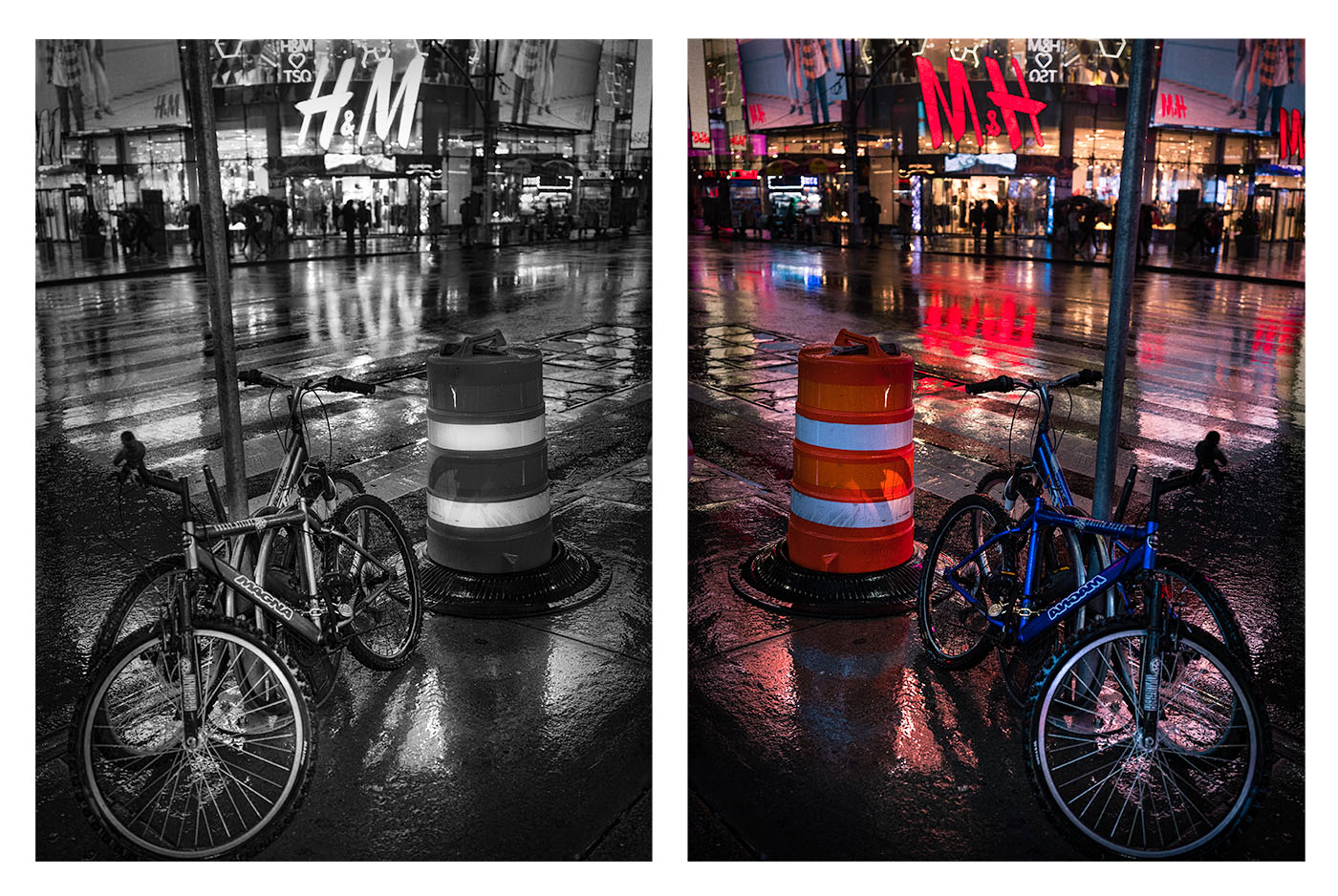
LIGHT PAINTING
Even if it is not something I’m doing a lot, this can be an interesting technique to play with when you search for interesting ways to create night photography.
You can use this technique either to bring more light on your subjects if that is needed or simply to experiment, play and get creative. Light painting can have practical use, or it can be done for purely creative reasons. This technique allows you to explore which shapes and secretes light painting can reveal and which you can remain in the shadows.
Regarding the practical use, the best example I can think of is when you want to shoot a subject at night and reveal all the important details, for instance in real estate night photography, where you may need to showcase a building with all the details that make up the façades and the environmental space. A popular technique, in that case, is to use strobes or flashes in different positions so you can light different areas or portions of the building or environmental space. You could either do that by using multiple flashes placed in different positions, which may not be very practical, or you can shoot multiple images while moving your flash to different positions and blend all those images in post-processing to create overall lit resulting image.
Another way to use light painting is to do it in order to increase the amount of light on different areas when you shoot out in nature and you don’t have any natural source of light. You can, for instance, use a flashlight to bring more light on a tree, a rock, or on some remote hut in the wilderness that you are photographing against the night sky. That will give volume to whatever subject you are shooting and will reveal the details you want to emphasize. You can, of course, be selective with your light painting and reveal only those areas or details that are important for your image.
There is another kind of light painting, which is more playful and where you can be as creative as you want. That is when you actually paint with light in a dark environment creating shapes that are visible against the background. This technique is similar to shooting light trails, only that you will create those trails yourself. To do that, you need to let your shutter open for the entire amount of time when you are light painting. You will use a source of light, for instance, a flashlight or a light stick (think the lightsaber in Star Wars) to make movements in a certain way which will create in the dark the shapes you want to see on your camera. A good tip if you want to experiment with this technique is to move fast and dress in black so you don’t risk being visible in the image.
ASTROPHOTOGRAPHY
Astrophotography is a sub-genre of night photography that I would actually classify as a genre on its own.
I will not make a very in-depth analysis of astrophotography since I consider this a different and very specific category of night photography and it deserves an independent detailed tutorial, but I want to mention a few things if you want to experiment with this photography style.
There are many things specific to astrophotography that you don’t encounter when shooting at night generally. For instance, there is the connection astrophotography has with astronomy and the requirement for the photographer to have some knowledge in that field to get the best out of this style of photography. This is one of the reasons why I think this genre of photography should be considered an independent genre.
However, astrophotography shares different aspects with other types of night photography, and it is quite an exciting and fascinating experience to shoot the stars, quite a challenging one as well, which actually makes it even more interesting.
Personally, I haven’t done astrophotography too much, or at least not as much as I would like to, but every time I worked with astrophotography, just like every time when I shoot at night, I find that an exciting experience and my intention for the future is to do more in this field.
Astrophotography is generally considered more as belonging to landscape photography because you need a completely dark sky to get good quality images of the stars, and the best environment to do that is the outdoors and preferably far from the city. The city lights can contaminate the scene and are always too powerful for you to be able to get really good images of the night sky.
The only time I got great skies when shooting the city skyline was some years ago when I was shooting at night on the Hydra Island in Greece and there was a failure at the island’s power plant. Due to this failure, the electricity was out all over the island all night until they fixed it in the morning. I was then in the island’s capital town and you could only see the streets and buildings in natural night light projected on the starry night sky with no other artificial light sources. I can tell you, that was a unique and inspiring moment and it was the only time I had the chance to shoot city photography while shooting astrophotography at the same time.
You can see one of the images I shot that night below. The image was shot with a Nikon 10-24mm f/3.5 – 4.5 G lens, and the settings were shutter speed 15 sec, aperture f/3.5, and ISO 3200.
So, if you want to shoot astrophotography in the city, the only thing you have to do is wait for a blackout and then go out and shoot away. Of course, that’s not going to happen very often, but you never know, so get ready for it and be on the lookout for it.

Speaking about the practical part of astrophotography, to be able to get a good image of the stars you need to shoot on nights without moon or before the moon rises. Those nights are the nights when the moon is in the new moon phase. Since the light coming from the stars is very faint anyway, the moonlight will inevitably fade that light so you risk losing the stars that are not very bright and even those that are bright will not be as visible as when you shoot on moonless nights. To find out when the moon is in the new moon phase, you can either check out a moon phase calendar or use an app that tracks the moon phases, for instance, PhotoPills.
STAR TRAILS vs. FROZEN STAR MOVEMENT
In astrophotography, night sky photography, or star photography, as it is also called sometimes, there are two approaches or so to say “schools of thought”. You can either aim to capture the star trails in your image or you go for capturing the stars frozen in their movement in the sky. Each of these approaches means a different technical approach and has specific requirements.
STAR TRAILS
One of the most important things, if you want to capture star trails, is to have a good orientation of your camera. What you aim for when you shoot star trails is to capture the circle the stars make in the sky while they travel during the night. Depending on how you want to shoot the circle, if you want to capture the entire circle or only parts of it, you will choose one orientation or another.
When you want to get the entire circle in the capture, you must orient yourself towards the North. The North Star, also called Polaris, will be the center of the circle. So you need to learn how to find the North Star. You will do this by using a map, a compass, or a phone app. Or by learning to do it yourself by learning more about the night sky. In this article, you will find more details about the North Star as well as how to find it by observing the night sky.
From my experience, the easiest way to find the North Star is to use a phone app. The app I am using most of the time for planning and orienting when I shoot outdoors is PhotoPills . There are other apps that do the same thing, some of them are astronomy apps, but PhotoPills has a lot of other features so it’s easier to have one app doing so many things. It is very easy to use this app, just like any other star-finding app. You only need to open it and point your phone to the sky and the app will show you where the North is and where the North Star should be.
To get the star trails, you will need to capture the sky over a longer period of time, usually more than an hour. You can do that in two ways. One approach is to shoot a long exposure covering the entire period of time. However, even if this works very well when you shoot film, with digital cameras for such a long exposure, you will have a lot of sensor noise, even with the best quality camera. We are still not yet there where we can take really long exposures without noise. In this respect, shooting film is still better than digital.
Another approach is to use technology to your advantage. What you can do is shoot multiple shorter exposures capturing fragments of the Star trails and stacking them together using Photoshop or other software that does this. This is the more universally used method because it gives you a better quality of the resulting image.
FROZEN STARS
In case you want to go for freezing the movement of the stars, as I did in the image above from Hydra Island in Greece, the approach will be different. The first and most important difference between the two approaches in astrophotography, star trails vs. immobile stars, is the length of the exposure. While, to create star trails you will use longer exposures, in order to freeze the stars you will need to use a shorter exposure, the shortest exposure possible for that particular situation.
The apparent movement of the stars is in fact given by the rotation of the earth. The earth is rotating relatively to the stars and this creates the impression when you look at the stars from Earth that the stars are moving. So we will use this expression since it is more intuitive. Since the stars are very far away and they move slowly, when I talk about shorter exposures, they can actually be as long as a few seconds. The stars may move during this period of time but they will not move as much as for the movement to be visible in the photograph. The intention is to use the longest short exposure possible, meaning an exposure that is long enough so you can capture enough light, but short enough so the stars don’t have time to create a light trail.
Because the exposure has to be relatively short, in order to get enough light into the camera you need to increase your ISO and open your aperture as much as possible, of course considering the noise in the case of the ISO and the depth of field in the case of the aperture.
Here is where the fast lenses come in handy and why I was suggesting earlier to use a wide-angle fast lens so you can open the aperture as much as possible.
What is generally used in terms of settings to be able to freeze the stars are the following.
– exposure: up to 15 seconds, – aperture: f/2.8 – f/3.5, – iso: 3200 – 6400.
If you can keep the exposure even shorter and the ISO even lower, that will give you an even better result, but these settings are widely used in astrophotography to freeze the motion of the stars as much as possible and they are a good starting point.
INSPIRATION FOR NIGHT PHOTOGRAPHY – THE PHOTOGRAPHY OF BRASSAÏ
When I think about night photography, the photographer whose night photography impresses and moves me the most is Brassaï. So I couldn’t miss mentioning his work in this complete guide to night photography. Brassaï was photographing during the Golden age of classic photography and he is one of those wonderful artists that paved the way for what photography has become today.
Brassaï (1899 – 1984) moved to Paris when he was young and created most of his work there photographing the city and the people, recording the evolution of the city and society as Paris was evolving in the 20 th century.
He extensively photographed by night, creating a recognizable style of atmospheric images that captured the magic of the Parisian atmosphere. He was one of the first photographers who photographed extensively night photography in the city and his work is a reference for everyone wanting to study night photography.
Brassaï’s night photography is truly inspiring. His low-light work has the artistic quality that all his photography work has. These images have the power to transport you back to the past when he was roaming the streets of Paris by night taking photos. Back then, shooting at night was much more challenging than it is nowadays, which makes his work all the more admirable and worth studying.
To get a better idea about his work, here is a video about the night photography of Brassaï, done by Ted Forbes and The Art of Photography, where he is browsing through one of the most well-known books showing Brassaï’s night photography, “Paris by Night”.
I’m sure you will enjoy this video. The book the author is talking about is apparently what is it to get and I warmly recommend it to you. I own it, and it is always a pleasure browsing through it.
If you are still here reading, congratulations! This was a long read and I hope you enjoyed it. It was long because I wanted to make it a complete guide to night photography that can help you get started with this magic style of photography, or it can give you ideas to learn to do it better and create even more inspiring night photography.
As I mentioned in the beginning, I will be adding new things to this guide as I get more ideas, as I do with all my articles. If you want to read the updates, subscribe to my website to receive all the news and be sure that you come back to read this article again, as well as the hundreds of other articles and tutorials you can find on the website.
The night is a magic time, full of mystery and promise. For this reason, photographing by night can be one of the most inspiring experiences you can have. All you need is to be open to this experience, to be well prepared, technically and in terms of planning, so you can unlock your artistic imaginativeness and use it to create great photography at night.
I hope this complete guide to night photography helps you in doing that and I’m looking forward to reading about your experiences and ideas related to night photography. Make sure you let me know about it in the comments below.
FURTHER STUDY RESOURCES
Fine art black and white photography, architecture photography, long exposure photography.
Find more resources about fine art black and white photography, (en)Visionography, long exposure photography and architecture photography in Julia Anna Gospodarou’s extensive collection of photography tutorials . To receive free future tutorials, you can subscribe here .
Learn more about how to create fine art photography, from vision to processing and the final image in Julia’s video course From Vision to Final Image – Mastering Black and White Photography Processing , in the video tutorial Long Exposure, Architecture, Fine Art Photography – Creating (en)Visionography , and the book From Basics to Fine Art – Black and White Photography , or by attending one of her highly appreciated workshops .
Find Julia’s recommendation for the best software and gear to create fine art photography and curated deals and discounts for these tools.
To study with Julia Anna Gospodarou personally, find out about our
Support our mission for quality photography education. donate, we believe in knowledge, education, and the freedom of spirit that creates great art. we believe in art and artists..
Please donate to help us continue sharing free quality photography education and inspiration.
For more than one and a half decades, we have been sharing free content on fine art photography, black and white photography, architecture photography, long exposure photography, as well as our original concepts of “(en)Visionography” and “Photography Drawing”.
Thousands of photographers started their journey in fine art photography here and found inspiration and practical resources that empowered them. Many have won awards for their work and are making a career in photography based on knowledge acquired from our free tutorials, books, courses, and workshops.
This makes us incredibly proud of our work.
To empower even more photographers to reach their dreams, we want to keep this resource free forever so every new or advanced photographer can have access to knowledge, quality photography education, and inspiration.
To help us in our efforts, please consider becoming a patron of this cause with your recurring donations.
You will be part of a generous effort by other exquisite art and photography-loving patrons, and you can be proud of being a supporter of art and artists like the famous Maecenas of the past. Art and artists need your support, as always in the history of art and photography.
Julia Anna Gospodarou – Founder – (en)Visionographer
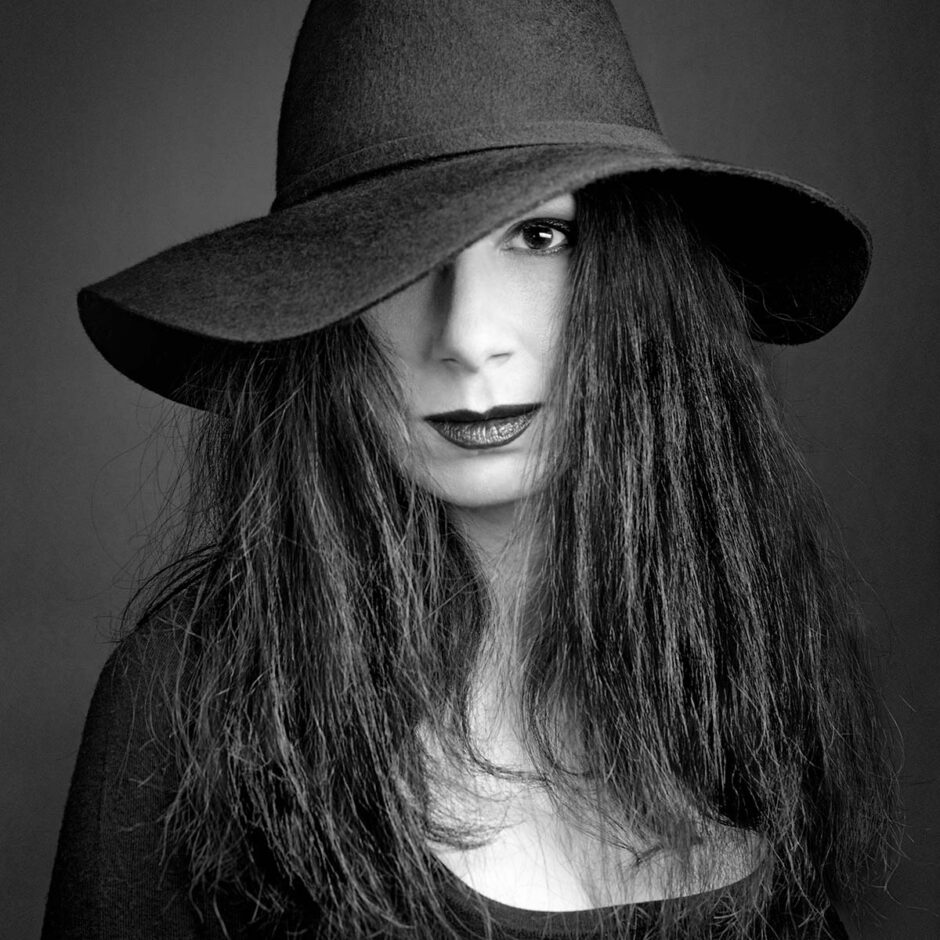
Founder of (en)Visionography™ and creator of Photography Drawing™, internationally acclaimed fine art photographer, architect, educator, and best-selling author, with 25+ years experience in photography and architecture, Julia Anna Gospodarou is a leader in modern fine art photography who shaped with her work the way architecture fine art photography looks today. Awarded more than 100 times in the most important photography competitions worldwide, two-time International Photography Awards IPA Photographer of the Year, World Photography Awards SWPA, and Hasselblad Masters Finalist, her work was widely exhibited and published internationally. With a passion for the world’s civilizations and speaking five languages, Julia was always in the avant-garde of thinking as an architect and a photographer, constantly pushing the limits of what is possible, constantly reinventing herself as an artist and an individual. Her huge love for travel and discoveries and her passion for teaching, art, and photography led her to become in the past one and a half decades one of the world’s top-rated fine art photography educators and workshop organizers .
Similar Posts

WHAT MAKES PHOTOGRAPHY ART?
WHAT MAKES PHOTOGRAPHY ART? CHARACTERISTICS THAT TRANSFORM PHOTOGRAPHY INTO ART What turns photography into art? What are those elements that differentiate fine art photography from descriptive photography? How do we step from the realm of observation and documentation into the realm of creation when we make photography? I’ve been asked this question many times by…
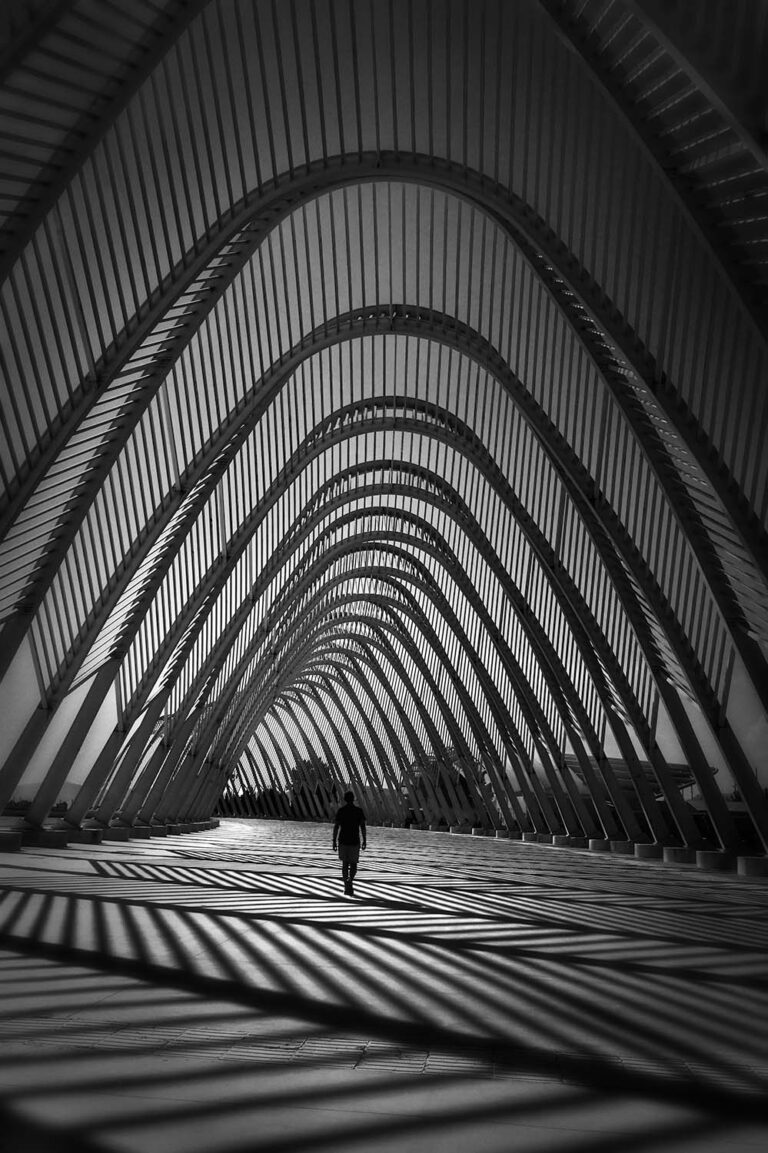
FINE ART ARCHITECTURAL STREET PHOTOGRAPHY
Fine art architectural street photography as a new direction in photography Waves of Imagination – Agora, Athens Olympic Center This is my last fine art architectural street photograph that I shot during my previous private photography workshop. These days I’m working with another student in Athens and, like every time I work with my photography students,…
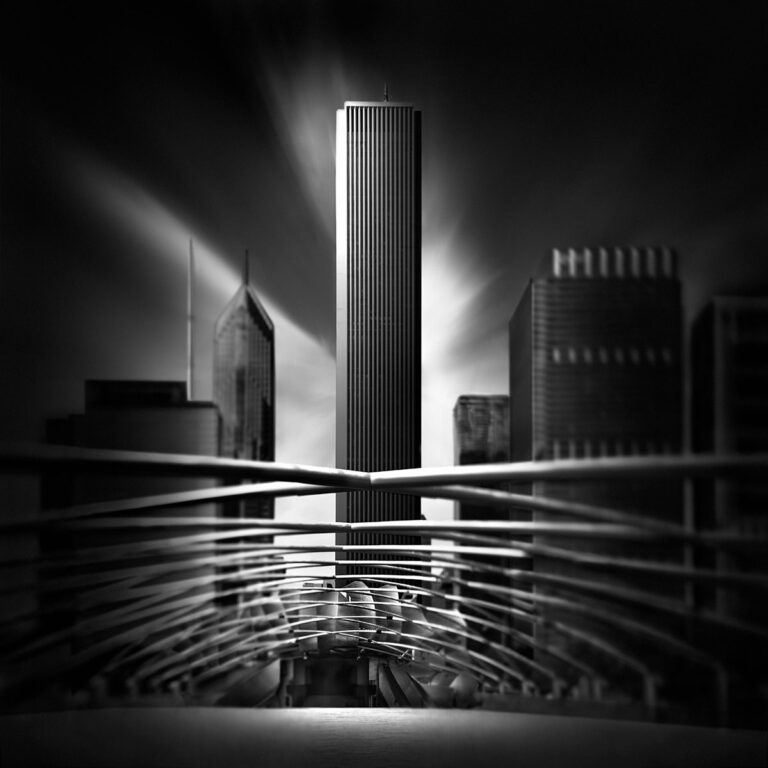
ARCHITECTURE AS PARALLEL REALITY – AN ANALYSIS OF FLUID TIME I
Architecture as Parallel Reality – An analysis of my image Fluid Time I Chicago – Jay Pritzker Pavilion (Architect Frank Gehry) & Aon Center (Architect Edward Durell) T/S LE = Tilt + Shift + Long Exposure Shot with Canon TS-E 24mm f/3.5L II – maximum tilt & shift, needed to maximize the OOFE (out of focus…
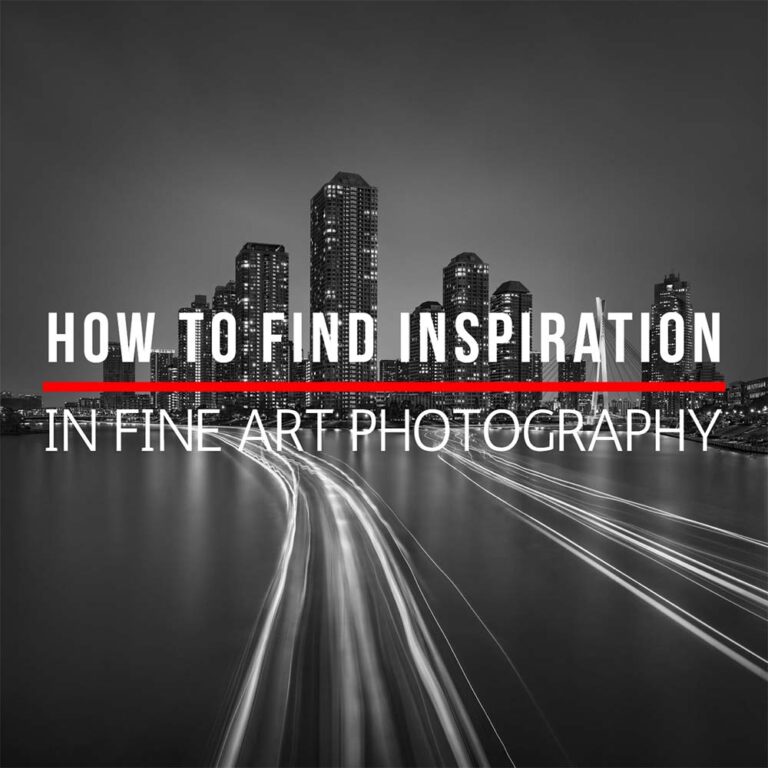
HOW TO FIND INSPIRATION IN FINE ART PHOTOGRAPHY – 15 TOP TIPS THAT DO WORK
HOW TO FIND INSPIRATION IN FINE ART PHOTOGRAPHY? HOW TO FIND INSPIRATION IN ART? How to find inspiration? This is one of the most important questions in art and one of the questions I hear most often from my photography students and from many other photographers. This is the first article in a series of…
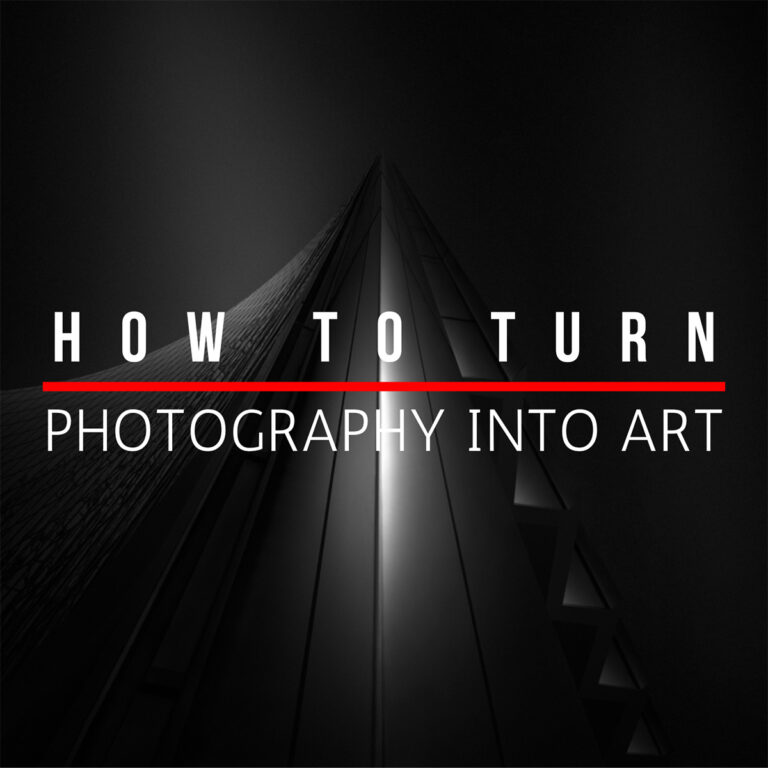
HOW TO TURN PHOTOGRAPHY INTO ART?
HOW TO TURN PHOTOGRAPHY INTO ART? CHARACTERISTICS THAT TRANSFORM PHOTOGRAPHY INTO ART How do we turn photography into art? How do we transform the act of taking a picture into creating a work that can inspire and trigger an emotional response in the viewer? How can we move ourselves and those coming in contact with…
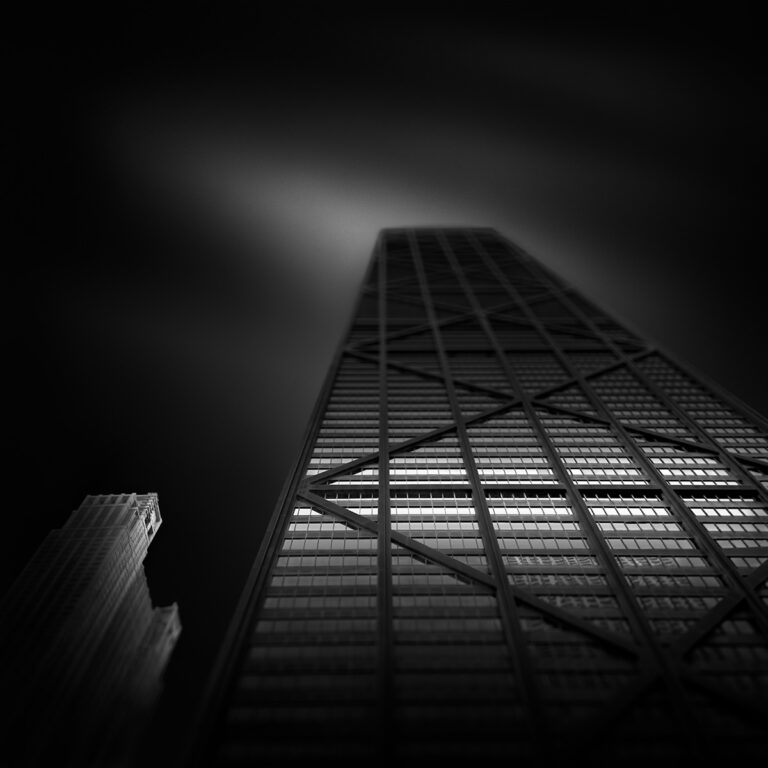
MEETING YOUR ARTISTIC PURPOSE – THE CREATION OF FLUID TIME III
About meeting your artistic purpose. How I created Fluid Time III – Two Worlds and how to be your own self in photography Hancock Tower, Chicago – Architects SOM This is the 3rd part of my (en)Visionographic Chicago Story, shot during my workshop in Chicago. This is one of the tallest (344 m), most impressive and fascinating buildings of…
Hello Anna, your comprehensive guide to night photography sounds truly impressive and helpful! I think it’s great how you describe the fascinating world of night and the opportunities for creative work in night photography. Thank you for sharing your knowledge and passion! Best regards, André
Thank you André! I’m glad you enjoyed it and found it useful. Best to you!
Leave a Reply Cancel reply
Your email address will not be published. Required fields are marked *
Yes, add me to your mailing list
Review Cart
No products in the cart.
STAY CONNECTED
Thank you for joining us! We'll get back to you shortly with great content. Please consider making a donation by clicking on the Donation button on our website. Thank you!

IMAGES
VIDEO
COMMENTS
WHITE BALANCE IN COLOR NIGHT PHOTOGRAPHY – WHIT A LITTLE HELP FROM SPECIAL FILTERS. In terms of capturing color night photography vs. black and white night photography, there are not many technical differences, except for the fact that you will need to be more careful with the color cast that light can have when shooting in color because it will be visible in your final image.